Dawn, rare snow—
shivering, I see
squirrels outside.
Once Careerealism Loses 4096 HP It Becomes Work It Daily
It turns out The Mezunian isn’t the only long-venerable institution to put on a fresh blanket o’ paint: finally that genius CEO with her decoder rings took my advice & changed her obnoxious half-pun website name to a catchier, hippin’-&-hoppin’ slangtang boomerang that all you kids in the dishes be shootin’ out your grins, & which is closer to its true subject matter: prostitution. Also, it’s a syllable ’way from sounding like a socialist rag—that’s cool, too.
Despite this, most o’ their articles still have “CAREEREALISM” in the top bar, since changing that would actually take effort.
& now their website has double the 2.0 Blandness & double the membership scams. Or maybe they always had that, & I just forgot, since most o’ their content has always been buried under 2.0 Blandness. Glad to see that web “professionals” still can’t be arsed to organize their shit into anything halfway coherent.
But they still have their #’d list articles, talking ’bout the same 5 topics they’ve been talking ’bout for years; & they still have clownishly exaggerated photos, such as this article’s image o’ a reader’s reaction ’pon 1st reading this site, which has tragically been ruined by the artist’s nephew scribbling on it with their half-transparent white crayon ‘gain.

I checked out this article ’bout tips for “Shy Networkers”—a topic they’ve ne’er written ’bout before—with a picture o’ a derp-face wondering when he could finally finish this photo & play his video games, mom. Lemme guess: the tips are all, “Don’t be shy.” Believe it or not, that’s giving this writer too much credit: after blabbing on for paragraphs ’bout their own bullshit I don’t care ’bout, they give 1 tip that’s essentially, “Don’t be shy,” & 4 that have nothing to do with shyness. I could’ve just written the sentence, “Stop being a crybaby,” & it would’ve been a better article than all 800+ words. That’s ’bout 80 Bashō haiku I could be reading ’stead.
Also, if you guys truly expect me to believe your rebranding is mo’ professional, I expect you guys to have better standards in your advertisements:

’Less you believe those conspiracy theories ’bout the electoral college, I think it’s too late for photo shoot o’ inebriated Hairpiece holding his arm round the stomach o’ bland bad actor in the least believable way possible is going to hurt Hairpiece’s chances o’ election. Just look @ his face: “Euughhh… ¿Are we done yet? ¡I want my cookies!” Still, we have to give Hairpiece credit for being a good ’nough sport to do a reenactment o’ the times he actually groped someone, & didn’t awkwardly hold his arm near someone for long ’nough for someone to take a clear photo.
& as for “10 Tips for People Who Hate Networking,” I can write a better sentence than that whole article, too: “Suck it up.” You guys oughta save your money & just hire me; then you can spend mo’ time making your redundant post pictures not look like you’re trying to film a Disney preteen movie, with bland white heroin going, “BEEP BOOP. THIS IS HOW THE FLESH HUMANS DEPICT BOREDOM & A GENERAL LACK O’ FULFILLMENT, ¿IS THAT ACCURATE?” While 4 decapitated crotches stand round ’hind her. ¡What great framing!

Do you associate networking with shameless self-promotion and ‘more = more’?
I mo’ associated this website with the former, whereas I associated the latter mo’ with the “Reflexive Property of Mathematics.”
Man, fuck this inane tripe: I’m mo’ interested in the strange political ads they have:

We have the e’en less believable photo o’ Hilary & Bill Clinton actually romantic toward each other, Robobama’s face malfunctioning, & Hairpiece squeezing his face gainst some random woman—or, as the ad claims, “Our Country’s Most Powerful.” Nope: till I see that picture replaced by Hairpiece smooching some fat, pasty-faced businessman Marrymore-style, I’m calling “false advertisement.” This ain’t working for me, Work It, Daily.
But ’cause I’m so generous to do so much o’ your work for you1, I’ll let my amazing Photoshop GIMP skills amend this:

(Well, close ’nough, a’least. ¿Did Hairpiece get any support from anyone powerful? It seems e’en they all didn’t want to waste their money on his nonsense.)
Anyway, I’ll just leave you all with that lovely image in your head.
¿LAS PUTO HOJAS SON DÉBILES? ERES DÉBIL.
Elm, Elm, Elm,
leaves are gone
¿so soon?
Hardly seen them.
Withered, crumpled, blackened…
¿But why these words?
¿Would we e’er call them towering, plain, eye-seeringly sickly green
in the o’erbearing summer?
Slowly…
I scoop them in my icy-dried granite hands—
But race, the thoughts—
I must, I can’t…
There’s nowhere to preserve them
from their abusive but necessary relation with the sun & clouds.
Let’s Code a Crappy 2D Platformer Like Millions o’ Other People on the Internet & Lose Interest & Give Up Only a Few Months In, Part VII
It’s not so much that I haven’t been working on my stupid project since my last post,–quite contrarily, I’ve been working on it mo’ than mo’ important work–but that I haven’t felt like there was much to show ’bout it. & I think talking ’bout refactoring out sprite movement code into “Movement Components” to separate gravity-based sprite movement from floating sprites & swimming sprites would be as interesting.
But I did make this nifty ice level that I wanted to show off.
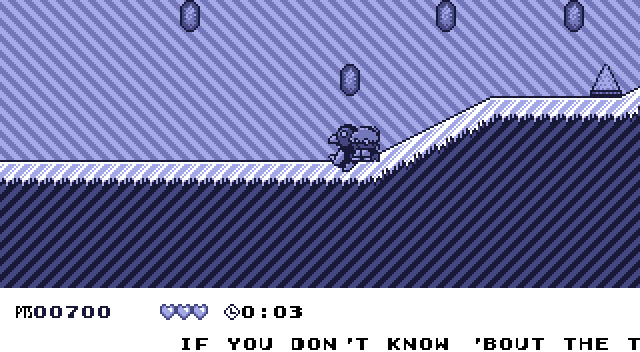
1st, we have penguin enemies that move back & forth, slowing to a skid as they turn. I e’en made it so that sliding into them (which still just uses Autumn’s ducking sprite) kills them.
That reminds me: I finally got it so that you hop off enemies when you land on them, ‘stead o’ some flaccid bounce that has no air. This was done by adding some bounce function to the grounded movement component & making it so that holding the jump button down while bouncing can extend it, but it can only be started by other means (landing on enemy heads so far).
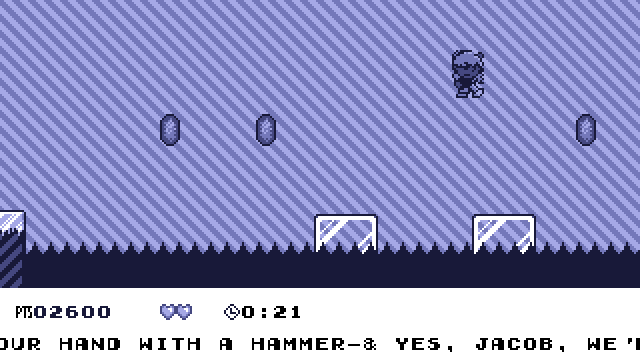
Next we have these big ice cubes that fall into water, stay floating on water, & start moving if you get on them. 2 ice cubes hitting each other causes them to turn in opposite directions, & hitting walls causes them to sink into the water.
Also, the water hurts Autumn from its icy coldness.
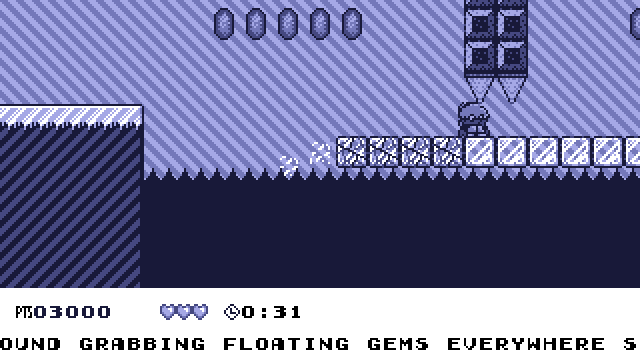
Lastly, unlike some other moving platform sprites that I’m not sure I e’en mentioned programming in yet, these ice cubes don’t keep Autumn’s X position with them, meaning that they can slip past Autumn, forcing the player to sort o’ fiddle with the controls to keep up with the ice cube. A li’l bit o’ challenge that… isn’t truly all that challenge.
Finally, I have smaller ice blocks that begin to shatter once you step on them. I also made them crack ‘pon hitting them from below, & then shatter when hit a 2nd time from below, but didn’t find a place to use them in this level. I’ve been wary ’bout avoiding making levels feel too big or fillery by trying to limit them to only a few, select, quick elements. As I was constructing this level, I worried that it may be too long, but ‘pon testing it I found that the fact that much o’ the level is large plots o’ land for breaks ‘tween water sections & the fact that your slippery movement makes you go faster, the level feels actually quite brisk.
I’m somewhat glad o’ how the graphics in this level turned out–though I fear the background may be a bit too similar to the background to Super Mario Bros. 3‘s ice levels. Then ‘gain, I think a few Kirby games used the same simple pattern. The ice blocks are also inspired by Super Mario Bros. 3, & the main ground is inspired by Kirby’s Adventure, but I think I differentiated them ‘nough. The only similarity ‘tween the grounds is that they both have shiny ice tops: while Kirby’s had rigid triangular shapes, mine has mo’ melty dripping lines. My ice blocks also have mo’ o’ the grungy dirt pixel shading I use for my other graphics (see the city graphics for particular examples) & have a different bevel on the right side.
Look, it’s hard to be particularly different when working in only 16 x 16 pixels. In such a case, these seemingly slight differences make a big difference–‘specially when you consider how oft commercial NES games seemed to ripoff other games. You have no idea how many times I see those Legend of Zelda stairs in other games.
I would talk ’bout a cart level I’d been working on before & a sewer level I’m working on, but I want to draw the cart sprite so the screenshots don’t show a tacky black square for the player for the former, & want to finish the latter, since it’s now mostly long stretches o’ water with few dangers.
I think I’ll focus less on “what I’ve done since last update” & mo’ on particular levels I’ve developed beyond an alpha stage. Which means, don’t expect ‘nother update till next year or so.
The Best Parts o’ the Bible
When the average person thinks o’ the Bible, they think o’ a few famous stories, like “Genesis,” “Exodus,” “Jonah,” & the 4 gospels, which make up only a tiny percentage o’ its bulk, most o’ which is made up o’ forgettable fluff o’ random Jews like Isaiah & Jeremiah1 ranting for pages & pages ’bout Jews being sinful, & all o’ Paul’s repetitive letters ranting @ Christians in almost incoherent ways2 ’bout being lazy & cheap bums & their insistence on the need to have the fetish for chopping baby boy penises—look, Jesus is no bigot: he’s neither gainst nor for baby-boy-penis-chopping.
But the best o’ the Bible is found in neither those famous books, nor any o’ that other dreck, but randomly buried in “2 Kings,” which is a loose collection o’ stories in which shitty things happen to Jews—also known as “What Happens in Real Life All the Time Throughout History.”
I present to you, what the New International Version calls, “Elisha Is Jeered” (chapter 2:23-24):
23From there Elisha went up to Bethel. As he was walking along the road, some youths came out of the town and jeered at him. “Go on up, you baldhead!” they said. “Go on up, you baldhead!” 24He turned around, looked at them and called down a curse on them in the name of the LORD. Then two bears came out of the woods and mauled forty-two of the youths. 25And he went on to Mount Carmel and from there returned to Samaria.
& for the record, no, this story has no relevance to anything surrounding it & could be taken out without affecting the narrative @ all. ¿But why would you want to cut out such a hilariously awesome scene?
E’en mo’ hilarious, 1 o’ my Bible’s many pretentious footnotes3 feels the need to establish that ’twasn’t Elisha who sicked the bears on them, but God, & that ’twasn’t for mocking Elisha’s bald head but for doubting God’s bear-spawning powers.
As an extra, here’s a gem from “1 Chronicles” 21:14:
Satan rose up against Israel and incited David to take a census of Israel.
Thank you, Bible, for inspiring thousands o’ gun nuts round the US to bring out their shotguns & threaten ’way those sinful gubbernit officials & their Satanic censuses.
Yeah, I know it’s s’posed to be a parable ’bout David’s pride in the hefty #s o’ his military; but that still doesn’t warrant the ridiculous melodrama o’ having Satan personally act “gainst Israel” in making a king act pompous—as if that’s not how every king that e’er existed has acted. I don’t remember the Bible talking ’bout Satan rising up gainst Israel when Solomon had o’er 700 wives.
O, all right, let’s talk ’bout a few mo’ lines.
Going back to “Kings,” I love how it keeps saying, “As for the other events of Solomon’s reign—all he did and the wisdom he displayed—are they not written in the book of the annals of Solomon?” (11:41), only for the footnote below it to say, “Nothing is known of ‘the book of the annals of Solomon.’ So I guess the answer to your question, narrator, is, “No.”
But ’nough ’bout that downer—how ’bout this great moral for good Christians from the great Apostle Paul himself (“2 Corinthians,” chapter 8:14-15):
14At the present time your plenty will supply what they need, so that in turn their plenty will supply what you need. Then there will be equality, 15as it is written: “He who gathered much did not have too much, and he who gathered little did not have too little.”
Translation: “From each according to his ability, to each according to his need.”
I’m glad to see my favorite US Constitutional amendment is supported by the other official US Constitution. It’s too bad I posted this a month too late: that would’ve made a great moral in which to celebrate Christmas Marxmas.
Though, my Bible, in an obvious attempt to mollify right-wingers, made sure to include a footnote in a later part in “Acts” chapter 4 talking ’bout apostles sharing things ’mong themselves that insisted it wasn’t communism ’cause ’twas s’posedly voluntary & s’posedly didn’t include all “private property” (personal property), which doesn’t apply in any communist system, either. This was sort o’ like the footnote for “2 Samuel” 1:26, which had to insist that King David’s claim that Jonathan’s “love for [him] was wonderful / more wonderful than that of women” was totally not gay.
But lets end this with the best, most profound moral o’ all, by Jesus himself (“Matthew” 5:13):
You are the salt of the earth. But if the salt loses its saltiness, how can it be made salty again?
That’s some Tsen shit right there.
2 pictures’ worth
poop scoop poop scoop poop scoop poop scoop poop scoop poop scoop poop scoop poop scoop poop scoop poop scoop poop scoop poop scoop poop scoop poop scoop poop scoop poop scoop poop scoop poop scoop poop scoop poop scoop poop scoop poop scoop poop scoop poop scoop poop scoop poop scoop poop scoop poop scoop poop scoop poop scoop poop scoop poop scoop poop scoop poop scoop poop scoop poop scoop poop scoop poop scoop poop scoop poop scoop poop scoop poop scoop poop scoop poop scoop poop scoop poop scoop poop scoop poop scoop poop scoop poop scoop poop scoop poop scoop poop scoop poop scoop poop scoop poop scoop poop scoop poop scoop poop scoop poop scoop poop scoop poop scoop poop scoop poop scoop poop scoop poop scoop poop scoop poop scoop poop scoop poop scoop poop scoop poop scoop poop scoop poop scoop poop scoop poop scoop poop scoop poop scoop poop scoop poop scoop poop scoop poop scoop poop scoop poop scoop poop scoop poop scoop poop scoop poop scoop poop scoop poop scoop poop scoop poop scoop poop scoop poop scoop poop scoop poop scoop poop scoop poop scoop poop scoop poop scoop poop scoop poop scoop poop scoop poop scoop poop scoop poop scoop poop scoop poop scoop poop scoop poop scoop poop scoop poop scoop poop scoop poop scoop poop scoop poop scoop poop scoop poop scoop poop scoop poop scoop poop scoop poop scoop poop scoop poop scoop poop scoop poop scoop poop scoop poop scoop poop scoop poop scoop poop scoop poop scoop poop scoop poop scoop poop scoop poop scoop poop scoop poop scoop poop scoop poop scoop poop scoop poop scoop poop scoop poop scoop poop scoop poop scoop poop scoop poop scoop poop scoop poop scoop poop scoop poop scoop poop scoop poop scoop poop scoop poop scoop poop scoop poop scoop poop scoop poop scoop poop scoop poop scoop poop scoop poop scoop poop scoop poop scoop poop scoop poop scoop poop scoop poop scoop poop scoop poop scoop poop scoop poop scoop poop scoop poop scoop poop scoop poop scoop poop scoop poop scoop poop scoop poop scoop poop scoop poop scoop poop scoop poop scoop poop scoop poop scoop poop scoop poop scoop poop scoop poop scoop poop scoop poop scoop poop scoop poop scoop poop scoop poop scoop poop scoop poop scoop poop scoop poop scoop poop scoop poop scoop poop scoop poop scoop poop scoop poop scoop poop scoop poop scoop poop scoop poop scoop poop scoop poop scoop poop scoop poop scoop poop scoop poop scoop poop scoop poop scoop poop scoop poop scoop poop scoop poop scoop poop scoop poop scoop poop scoop poop scoop poop scoop poop scoop poop scoop poop scoop poop scoop poop scoop poop scoop poop scoop poop scoop poop scoop poop scoop poop scoop poop scoop poop scoop poop scoop poop scoop poop scoop poop scoop poop scoop poop scoop poop scoop poop scoop poop scoop poop scoop poop scoop poop scoop poop scoop poop scoop poop scoop poop scoop poop scoop poop scoop poop scoop poop scoop poop scoop poop scoop poop scoop poop scoop poop scoop poop scoop poop scoop poop scoop poop scoop poop scoop poop scoop poop scoop poop scoop poop scoop poop scoop poop scoop poop scoop poop scoop poop scoop poop scoop poop scoop poop scoop poop scoop poop scoop poop scoop poop scoop poop scoop poop scoop poop scoop poop scoop poop scoop poop scoop poop scoop poop scoop poop scoop poop scoop poop scoop poop scoop poop scoop poop scoop poop scoop poop scoop poop scoop poop scoop poop scoop poop scoop poop scoop poop scoop poop scoop poop scoop poop scoop poop scoop poop scoop poop scoop poop scoop poop scoop poop scoop poop scoop poop scoop poop scoop poop scoop poop scoop poop scoop poop scoop poop scoop poop scoop poop scoop poop scoop poop scoop poop scoop poop scoop poop scoop poop scoop poop scoop poop scoop poop scoop poop scoop poop scoop poop scoop poop scoop poop scoop poop scoop poop scoop poop scoop poop scoop poop scoop poop scoop poop scoop poop scoop poop scoop poop scoop poop scoop poop scoop poop scoop poop scoop poop scoop poop scoop poop scoop poop scoop poop scoop poop scoop poop scoop poop scoop poop scoop poop scoop poop scoop poop scoop poop scoop poop scoop poop scoop poop scoop poop scoop poop scoop poop scoop poop scoop poop scoop poop scoop poop scoop poop scoop poop scoop poop scoop poop scoop poop scoop poop scoop poop scoop poop scoop poop scoop poop scoop poop scoop poop scoop poop scoop poop scoop poop scoop poop scoop poop scoop poop scoop poop scoop poop scoop poop scoop poop scoop poop scoop poop scoop poop scoop poop scoop poop scoop poop scoop poop scoop poop scoop poop scoop poop scoop poop scoop poop scoop poop scoop poop scoop poop scoop poop scoop poop scoop poop scoop poop scoop poop scoop poop scoop poop scoop poop scoop poop scoop poop scoop poop scoop poop scoop poop scoop poop scoop poop scoop poop scoop poop scoop poop scoop poop scoop poop scoop poop scoop poop scoop poop scoop poop scoop poop scoop poop scoop poop scoop poop scoop poop scoop poop scoop poop scoop poop scoop poop scoop poop scoop poop scoop poop scoop poop scoop poop scoop poop scoop poop scoop poop scoop poop scoop poop scoop poop scoop poop scoop poop scoop poop scoop poop scoop poop scoop poop scoop poop scoop poop scoop poop scoop poop scoop poop scoop poop scoop poop scoop poop scoop poop scoop poop scoop poop scoop poop scoop poop scoop poop scoop poop scoop poop scoop poop scoop poop scoop poop scoop poop scoop poop scoop poop scoop poop scoop poop scoop poop scoop poop scoop poop scoop poop scoop poop scoop poop scoop poop scoop poop scoop poop scoop poop scoop poop scoop poop scoop poop scoop poop scoop poop scoop poop scoop poop scoop poop scoop poop scoop poop scoop poop scoop poop scoop poop scoop poop scoop poop scoop poop scoop poop scoop poop scoop poop scoop poop scoop poop scoop poop scoop poop scoop poop scoop poop scoop poop scoop poop scoop poop scoop poop scoop poop scoop poop scoop poop scoop poop scoop poop scoop poop scoop poop scoop poop scoop poop scoop poop scoop poop scoop poop scoop poop scoop poop scoop poop scoop poop scoop poop scoop poop scoop poop scoop poop scoop poop scoop poop scoop poop scoop poop scoop poop scoop poop scoop poop scoop poop scoop poop scoop poop scoop poop scoop poop scoop poop scoop poop scoop poop scoop poop scoop poop scoop poop scoop poop scoop poop scoop poop scoop poop scoop poop scoop poop scoop poop scoop poop scoop poop scoop poop scoop poop scoop poop scoop poop scoop poop scoop poop scoop poop scoop poop scoop poop scoop poop scoop poop scoop poop scoop poop scoop poop scoop poop scoop poop scoop poop scoop poop scoop poop scoop poop scoop poop scoop poop scoop poop scoop poop scoop poop scoop poop scoop poop scoop poop scoop poop scoop poop scoop poop scoop poop scoop poop scoop poop scoop poop scoop poop scoop poop scoop poop scoop poop scoop poop scoop poop scoop poop scoop poop scoop poop scoop poop scoop poop scoop poop scoop poop scoop poop scoop poop scoop poop scoop poop scoop poop scoop poop scoop poop scoop poop scoop poop scoop poop scoop poop scoop poop scoop poop scoop poop scoop poop scoop poop scoop poop scoop poop scoop poop scoop poop scoop poop scoop poop scoop poop scoop poop scoop poop scoop poop scoop poop scoop poop scoop poop scoop poop scoop poop scoop poop scoop poop scoop poop scoop poop scoop poop scoop poop scoop poop scoop poop scoop poop scoop poop scoop poop scoop poop scoop poop scoop poop scoop poop scoop poop scoop poop scoop poop scoop poop scoop poop scoop poop scoop poop scoop poop scoop poop scoop poop scoop poop scoop poop scoop poop scoop poop scoop poop scoop poop scoop poop scoop poop scoop poop scoop poop scoop poop scoop poop scoop poop scoop poop scoop poop scoop poop scoop poop scoop poop scoop poop scoop poop scoop poop scoop poop scoop poop scoop poop scoop poop scoop poop scoop poop scoop poop scoop poop scoop poop scoop poop scoop poop scoop poop scoop poop scoop poop scoop poop scoop poop scoop poop scoop poop scoop poop scoop poop scoop poop scoop poop scoop poop scoop poop scoop poop scoop poop scoop poop scoop poop scoop poop scoop poop scoop poop scoop poop scoop poop scoop poop scoop poop scoop poop scoop poop scoop poop scoop poop scoop poop scoop poop scoop poop scoop poop scoop poop scoop poop scoop poop scoop poop scoop poop scoop poop scoop poop scoop poop scoop poop scoop poop scoop poop scoop poop scoop poop scoop poop scoop poop scoop poop scoop poop scoop poop scoop poop scoop poop scoop poop scoop poop scoop poop scoop poop scoop poop scoop poop scoop poop scoop poop scoop poop scoop poop scoop poop scoop poop scoop poop scoop poop scoop poop scoop poop scoop poop scoop poop scoop poop scoop poop scoop poop scoop poop scoop poop scoop poop scoop poop scoop poop scoop poop scoop poop scoop poop scoop poop scoop poop scoop poop scoop poop scoop poop scoop poop scoop poop scoop poop scoop poop scoop poop scoop poop scoop poop scoop poop scoop poop scoop poop scoop poop scoop poop scoop poop scoop poop scoop poop scoop poop scoop poop scoop poop scoop poop scoop poop scoop poop scoop poop scoop poop scoop poop scoop poop scoop poop scoop poop scoop poop scoop poop scoop poop scoop poop scoop poop scoop poop scoop poop scoop poop scoop poop scoop poop scoop poop scoop poop scoop poop scoop poop scoop poop scoop poop scoop poop scoop poop scoop poop scoop poop scoop poop scoop poop scoop poop scoop poop scoop poop scoop poop scoop poop scoop poop scoop poop scoop poop scoop poop scoop poop scoop poop scoop poop scoop poop scoop poop scoop poop scoop poop scoop poop scoop poop scoop poop scoop poop scoop poop scoop poop scoop poop scoop poop scoop poop scoop poop scoop poop scoop poop scoop poop scoop poop scoop poop scoop poop scoop poop scoop poop scoop poop scoop poop scoop poop scoop poop scoop poop scoop poop scoop poop scoop poop scoop poop scoop poop scoop poop scoop poop scoop poop scoop poop scoop poop scoop poop scoop poop scoop poop scoop poop scoop poop scoop poop scoop poop scoop poop scoop poop scoop poop scoop poop scoop poop scoop poop scoop poop scoop poop scoop poop scoop poop scoop poop scoop poop scoop poop scoop poop scoop poop scoop poop scoop poop scoop poop scoop poop scoop poop scoop poop scoop poop scoop poop scoop poop scoop poop scoop poop scoop poop scoop poop scoop poop scoop poop scoop poop scoop poop scoop poop scoop poop scoop poop scoop poop scoop poop scoop poop scoop poop scoop poop scoop poop scoop poop scoop poop scoop poop scoop poop scoop poop scoop poop scoop poop scoop poop scoop poop scoop poop scoop poop scoop poop scoop poop scoop poop scoop poop scoop poop scoop poop scoop poop scoop poop scoop poop scoop poop scoop poop scoop poop scoop poop scoop poop scoop poop scoop poop scoop poop scoop poop scoop poop scoop poop scoop poop scoop poop scoop poop scoop poop scoop poop scoop poop scoop poop scoop poop scoop poop scoop poop scoop poop scoop poop scoop poop scoop poop scoop poop scoop poop scoop poop scoop poop scoop poop scoop poop scoop poop scoop poop scoop poop scoop poop scoop
1st Web Designer Straight Trollin’ Me (feat. Marketslide—¡Wheeee!)
Comprehensive Beginner Guide to Choosing a Web Host
O, fun. I can already guess what I’m going to get from this: those luscious affiliate links. Since every host review on the planet has affiliate links—e’en those that criticize corrupt web host reviews, ironically—I can only imagine that a website as corrupt as 1st Web Designer’s jumping into the money bag, too. Well, let’s dive in like Scrooge…
In fact, I’m just going to skim ’head, just to… Wait, ¿What?
Things You should NOT Consider when Choosing a Web Host
Phh, “Listen to 1st Web Designer,” ¿amirite?
No. That’s not a word. I’m sick o’ your linguistic blasphemy.
Read Reviews Online Using Google Search
¿Huh? Mmm… Well, on 1 hand, it’s a bit hypocritical, considering how many times I see 1st Web Designer litter my Google searches. But, it’s not bad advice.
Yes, all of those links are affiliates, wherein each sale pays a small fee to the recommending site. Drupal.org is just one example – all across the internet, hosting reviews are all about affiliate links. This is why certain firms score well in hosting reviews (owing to heavy affiliate commission), but fare badly in overall user service.
…
Huh. Well, I can only wait breathlessly for the ironic—
Yes, that’s right. While the allure of earning big bucks by getting others to click on links is tempting, we have ensured that this article is totally unbiased – this article does not contain affiliate links because we know and appreciate the importance of a proper web host.
…
(Scours page for hours. Can’t find any affiliate links.)
All right, 1st Web Designer: you’ve got me. After your vaguely corrupt recommendation for “CONVERTING” websites, wherein one just cobbles together whatever free shit one can find online when “making” sites for clients, rather than actually doing your job, you’re the only site that talks ’bout web host recommendations that doesn’t take affiliate links.
&, ¿what the fuck? I just noticed: this article not only talks ’bout what the title promises, it starts talking ’bout the topic immediately & doesn’t stray into irrelevant topics for mo’ than half o’ the article.
There’s only 1 explanation: 1st Web Designer made this article just to screw with me. They know I’m making fun o’ their articles & wrote a competent article just to make me look stupid. Get out o’ my monitor.
O well, I’m sure their advice is dumb, anyway.
Everyone knows what shared hosting is, VPS, and reseller hosting packages.
If this article weren’t given the same mysterious author o’ “Editorial Team” as all the other articles, I’d insist that this article must be written by somebody other than the person who thought Photoshop was a programming language. Nope. That’s some knowledge dissonance.
E’en mo’ hilarious, I looked up that link & found that it goes to a completely different page—1 with a title that actually indicates what they’re talking ’bout, & which is, in general, actually competent. Granted, its info is rather vague, & it still has dumb images, including some dumb meme pic; but compared to the original, this is like Sonichu to Gunnerkrigg Court. Way to ruin my fun.
On the other hand, a’least some o’ the info they gave was rather insightful: I had no idea till now that US Speaker o’ the House moonlighted as 1 o’ Marketslide’s (¡Wheeee!) founders. ¿Or is that Paul Xavier? Either that guy’s worried that he might hurt his company by being linked to whatever controversy might be involved in political issues or he just likes to consider himself to be a renegade angel. That’s OK, their company name can’t seem to make up its mind, either: while most o’ the site calls it “Marketslide,” (¡Wheeee!) the title bar @ the top says “Market Slide.”
Speaking o’ which, I can’t tell what they’re selling, since I’m only Level 2 in my Buzzwordese classes, I can only assume by their header @ the top that they sell gorgeous sunset mountains.
Just in case you don’t, simply do a Google search!
O, yeah, we were reviewing an article.
I do have to bicker ’bout this, though: in the time it took you to type that, you could’ve quickly found some links to Wikipedia & put them there. I find it hard to believe that someone could find this article, but not figure out how to search for something on Google, ’specially since Google is most likely how they found this article in the 1st place. (1st Web Designer certainly seems to be aiming its content toward SEO.)
(Yawn.) In general, this article has competent info: it talks ’bout the gotchas you need to watch out for, such as “unlimited” bandwidth & disk space; it talks ’bout the importance o’ what one plans to do with one’s website, such as how big it’ll be, & how that affects what choice is best; & talks ’bout CDNs.
Also, ¿what’s up with “v/s” used when talking ’bout bandwidth & disk space? ¿What was wrong with “vs.”? ¿What kind o’ weirdo just randomly spells words ’nother way & uses strange punctuation like that?
Let’s Code a Crappy 2D Platformer Like Millions o’ Other People on the Internet & Lose Interest & Give Up Only a Few Months In, Part VI
I promised to neglect keeping up on these, & I kept my promise.
Most o’ what I’ve done was mo’ design than programming, but it did involve programming in quite a bit o’ custom sprites.
Wasabi Woods
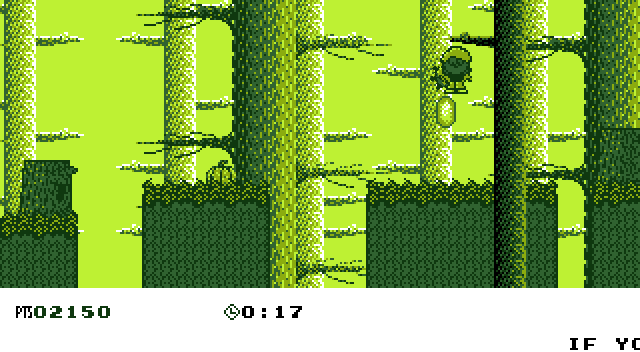
Planned to be the 1st forest level & 2nd level o’erall. For it I created “Bad Apple” enemies, which are basically just Goombas that bop off screen when you jump on them & still have no animation.
A mo’ interesting sprite I use is some spike fruit that start falling if you get near them horizontally & respawn after falling offscreen.
Sawdust Crush
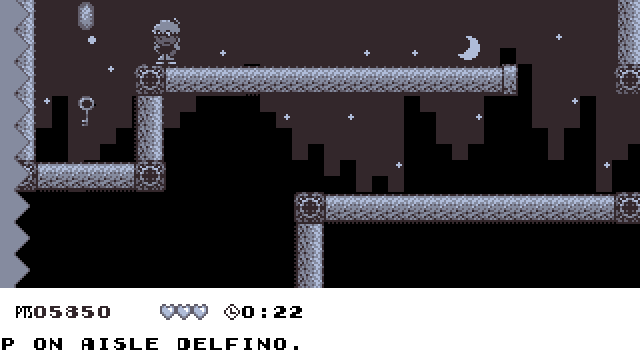
Finished this level. 1 programming quirk: to keep players from being able to jump o’er walls, I had to make the camera go much higher; however, ’cause the camera isn’t s’posed to scroll vertically, I included camera-lock variables to maps which prevents the camera from scrolling past that variable (camera’s y_ variable going greater than the map’s top_limit_).
Desert Dare
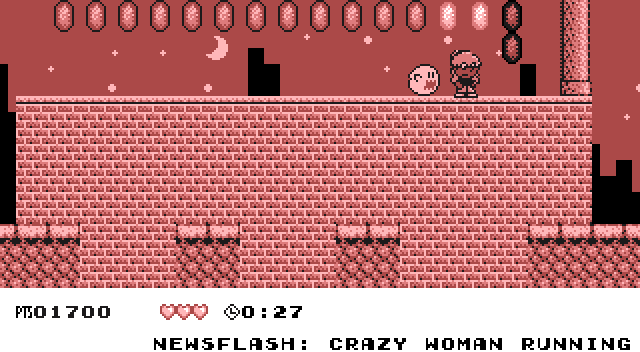
A joke level, using mostly graphics I made for some other sprite comic. If your character moves in any way, you lose.
I wanted to program it so that it tested whether the protagonist’s is_moving_ is true, but found it impossible to keep is_moving_ from being set to true a’least once before testing, & found adding a timer to the goal to be cumbersome when there was a simple solution to just test for input presses.
Rooftop Rumble
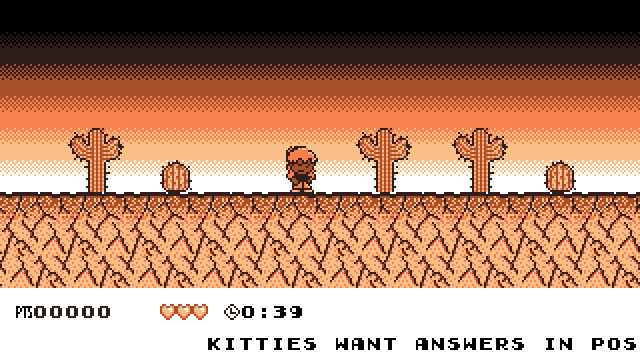
You may recognize this as “Skyscraper Caper.” I plan to have this be the final city level, I think.
¿Remember when I said I wanted this to be the player racing some other sprite ’stead o’ racing gainst a dumb clock, but found creating a sprite that can jump & run with good timing too complicated? I found a balance, inspired by Super Mario Bros. Deluxe: the player races gainst a ghost who can fly through everything to the goal.
Logically, I should probably check for the ghost to touch the goal block, but I was lazy, & just checked for the ghost to pass an x value that happens to be where I placed the goal.
Speaking o’ laziness, I still haven’t drawn a ghost sprite, & worse, stole 1 directly from Super Mario Bros. Deluxe. Obviously I don’t plan to keep this bit o’ copyright infringement, if it e’er reaches any final form.
Golden Gear Solid
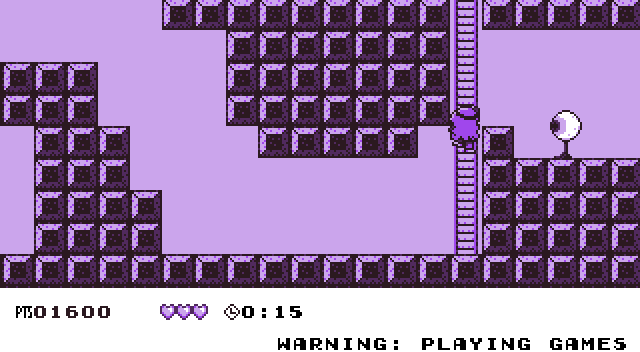
I don’t know what theme I plan to have this in yet, but due to its length & difficulty,—every hit is an instant-kill—it’ll probably be near the end. I actually kinda worry that this level might be too frustrating: I fear it might require too much possibly-unintuitive camera finagling or knowing subtle, e’en-mo’-unintuitive, facts o’ how the level’s rules work. There’s 1 point, for instance, wherein one’s safe if one stands still, but if one falls down the next hole while the guard is looking out, one will be caught (as the rules state in the info box @ the beginning, guards can see mo’ high up if you’re in the air, to make it harder to just jump o’er guards). There’s ’nother part where you’re just s’posed to follow some gems into an alcove a let a guard ’bove you pass o’er you, which actually has no difficulty whatsoe’er, which is the goal; but if the player jumps up there, they’ll get caught before they e’en see the guard. They probably wouldn’t e’er get hit ’gain; but it’s still a possibly-frustrating piece o’ accidental trial-&-error. Also, I feel having to ’splain this level’s rules in a word dump @ the beginning probably means this level’s gimmick might be too complicated for it’s own good, ’specially with instant-death fails. It feels like a recipe for “scrappy mecahnic.”
Then ’gain, ¿what’s a good platformer without just 1 “that one level” that everyone dreads having to beat to get back to the fun levels? After all, if Donkey Kong Country 2 can still be a classic with “Windy Well,”1 ¿why can’t I include my own?
Believe it or not, I figured out how to update the guard sprite so that it can’t see past solid blocks. All I had to do was add a method to the SpriteSystem class to check if there are any blocks within a given set o’ coordinates—the familiar SDL_Rect coordinates, x, y, width, & height. Then there was the problem wherein the guards were blocked by gems, which was solved by saving the block type ID into each block & testing for the block being having certain ID. There’s still a quirk wherein the guards won’t see the player ’less the player’s completely out from ’hind blocks, e’en if only the tip o’ their feet is ’hind blocks, but this gives the player leeway, & it’s not as if being able to jump mo’ than one’s height is realistic, either.
I also added extra camera controls to scroll the camera upward & downward without having to duck or look up, so you can scroll when on the stairs, which makes the stairs section much easier. Having the camera operate on WASD controls feels much mo’ natural than having “A” & “S” arbitrarily be left & right, anyway.
Bough Down
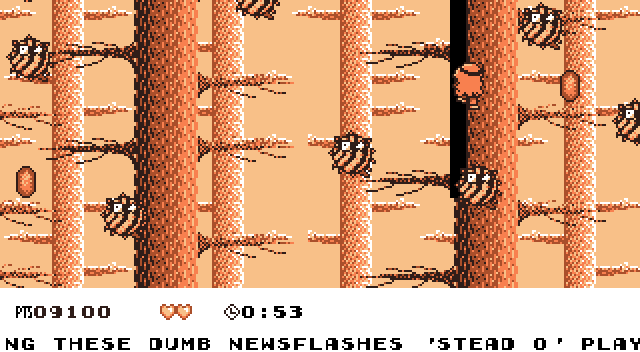
The last level I finished. I plan to have this be the 2nd forest level.
This, has 3 sprites: branches that fall ’pon landing on them, a rope that starts moving horizontally once you grab onto it, & bees. The 1st 2 use a different respawning code that I should probably apply to all non-killed sprites: they respawn, but only if their current & original positions are off-screen (the latter to prevent them from suddenly popping back into view).
The bees actually have 4 forms: the 1st just floats where it’s placed, buzzing round erratically; 1 moves right & left; ’nother moves up & down; & the final flies in a circle. I was surprised how simple the final 1 was to program, thanks to the power o’ simple math (which I didn’t know till recently, since I have no formal trigonometry education).
Technically, I’m not finished. It should be obvious that the “rope” sprite’s art isn’t finished–as in, it’s currently just a black rectangle. But I also thought ’bout extending the final bee section, since I still think it’s a bit too short & too easy.
Level Organization
I don’t know if I mentioned yet the level layout scheme I’m planning. It’s actually an idea I originally planned for a Super Mario World rom hack years ago, which I codenamed “Spiral.” The gimmick is that rather than splitting the game into worlds o’ consistent themes—forest world followed by desert world, & so on—the game cycles through level themes, with each cycle being the equivalent o’ a world. Hence why I have an early-game city level & a late-game city level planned. The main inspiration was the Super Nintendo & Sega Genesis Cool Spot, which had an interesting gimmick wherein it’d cycle through level themes till the middle o’ the game, & then cycle backward from those themes till the end. Thus, the beach theme is used for the 1st & last level, the pier theme is used for the 2nd & penultimate levels, & so on.
The Future
A few levels I’m working on:
Minty Mines
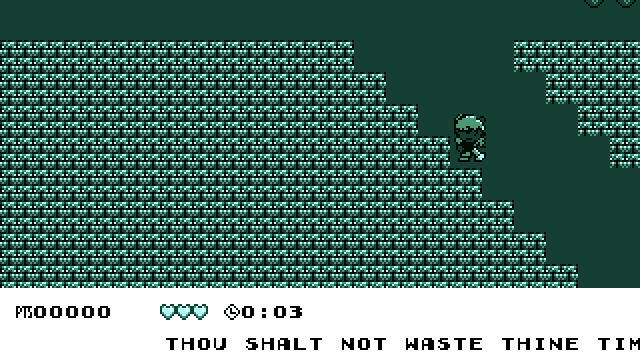
Planned to be the 1st-cycle mine level & the 3rd level o’erall. Only idea I have so far is that I want it to be ’bout finding the key & then returning to the start, where the chest is. I want it to be a bit mo’ like exploration than “Wasabi Woods,” but can’t think o’ much to make it interesting.
The Minus Touch
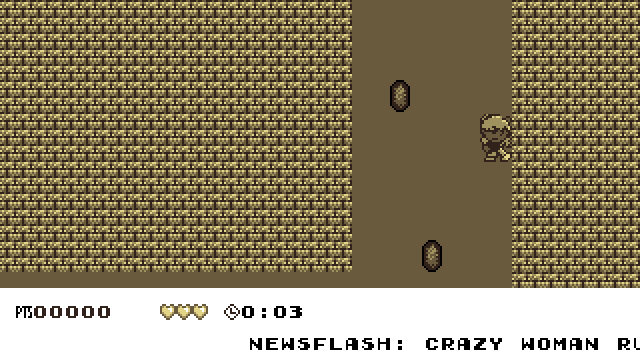
The 1 where if you collect any gems, you fail. Planned to be an end-game mine level. Still not sure what I want to do with it, in terms o’ actual puzzles, other than that I want the # o’ gems you have to dodge to increase, till the end, where you’re mostly surrounded by gems.
Snow-themed levels
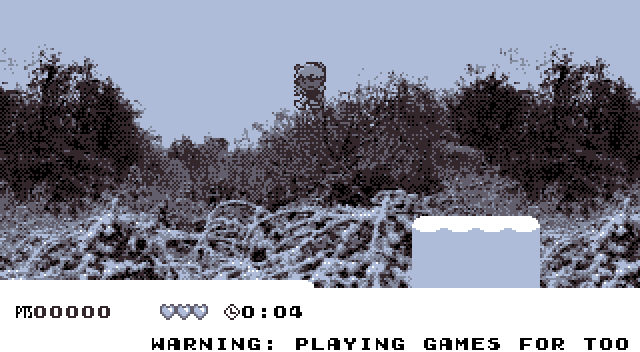
I made this nifty background using a photo I took o’ some line o’ trees a few blocks from my house when it snowed a few weeks ago:
My only worry is that the background might be so detailed—& yet so pixelated, due to my arbitrary color limits—that it might be hard to see things in it, which may detract from gameplay. When I was 1st working on it, I actually also made some trees using ’nother photo, ’bout thought it might be too cluttered. Also, I couldn’t get rid o’ some artifacts round the trees, making them look ugly in front o’ any other background.
I also programmed in slippery controls, which go into effect for any map with a slippery_ flag turned on.
I had a few ideas for icy levels, such as an icy cave level & a level full o’ floating ice bergs wherein touching the ice-cold water is instant death. I also thought the levels where your character runs forward regardless o’ what you do would work well with this theme, since it could be ’splained with the icy floor. However, I also wanted to change the death-on-touching-a-wall thing so that you could jump up after upward slopes; but that isn’t in my games physics for slopes yet.
’Nother idea I had was to change snow physics so that it’d be slower & mo’ plodding, as opposed to icy floors, which would be slippery, based on my experience having to walk in snow vs. icy roads while going to the store & such.
Bonus
As an extra, as I was cleaning my room ’cause my fascist mom told me I had to or no mo’ nutty bars after dinner to find some lost library books, I found some ol’ papers I’d made a year or so ago during my lunch break @ work while masturbating to photos o’ sexy cascade mountains & firs. Wait, ¿which did I cross out ’gain?
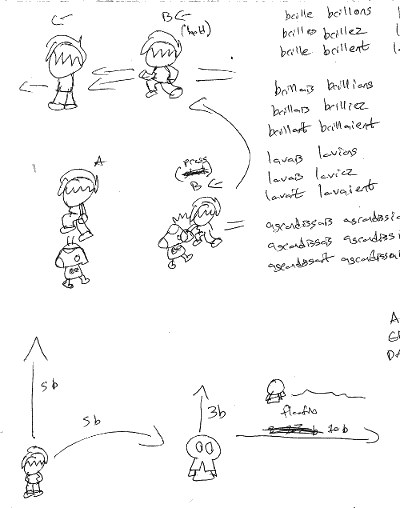
1st we have some simple sketches o’ how I planned Autumn to move ’bout (Ignore my French verb practice). You can see 2 differences here than what I have so far: Autumn’s proposed ability to punch, & the addition o’ Edgar as ’nother possible character, who has a shorter hop, but can float (so, essentially, Autumn would be like Luigi & Edgar like Peach in Super Mario Bros. 22).
I probably won’t be implementing any o’ these. Honestly, I like the simplicity o’ the controls currently (which is already hampered by the camera controls), & find the punch is unnecessary, since jumping on enemies is sufficient, & feels mo’ natural than stopping to punch, & keeps gameplay focused. Actually, @ 1 point I planned on not letting you kill enemies @ all, but thought making your character that impotent made it feel a li’l less fun.
As for the different characters, that’d require me to redesign the levels I’ve done to keep them balanced (right now one needs to be able to jump as high as Autumn to reach some platforms). Plus, keeping characters balanced so that none seem useless would be hard. Already it seems as if Edgar would be a superior character in this case—which doesn’t e’en fit within the source material.
Beta Blueberry Burroughs
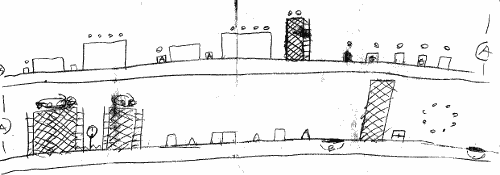
Here we see the original plan for the 1st level. I should point out that these maps were ne’er drawn to be perfect representations o’ what I wanted, but just quick scribbles o’ ideas.
While none o’ the others were actually technically used as references for levels, since I didn’t find these till a few days ago, this 1 might’ve, since I faintly remember an earlier form o’ this level already being designed in Tiled from a year ago or so—including the ending, which isn’t in this paper plan. This is certainly the closest o’ the paper maps to what I have now: as you can see by the solid wall requiring hops ’long 2 roofs; the short hopping sections o’er spikes using hydrants; the short spike pit ’tween 2 roofs with a ! sign o’er it; & the sewer warp to get from 1 half to a li’l past the other, with a pattern o’ gems hid ’hind it, I already had many o’ the same ideas earlier. The main difference ’tween my current & the final was that neither this paper plan, nor the Tiled map I made a while ago had the hidden gems just left o’ the starting point; that was a recent addition. (Also, in general, I changed a lot o’ the gems round since adding the brighter & darker gems & changing the requirement from 50 gems to 10,000 ₧—round 70 or so gems.)
Extra trivia: I had the name “Blueberry Burroughs” in mind for a while, as well.
Alpha Wasabi Woods
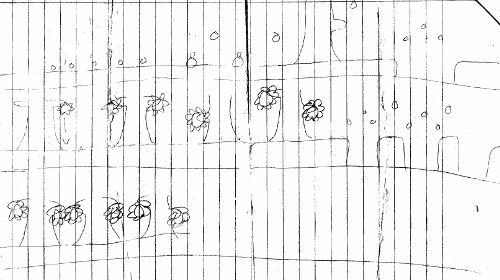
& here we see that the “Wasabi Woods” early map is much different from what I have now—not to mention much rougher. All that’s truly similar is that I always planned for there to be the “Bad Apple” enemies & the falling spiky fruit. I also always planned for there to be a final gauntlet with a long row o’ falling spiky fruit.
There was also an early Tiled map, but ’twas unfinished up to round where the trees appeared—which made sense, since I’d ne’er programmed falling spike fruit before. But as we can see comparing that beginning to this paper map, they differed as well: I apparently planned to have far fewer bottomless pits &, in general, a much easier level. Part o’ me does think the current version might be a bit too hard, actually, so I may moderate it a bit—though not this much.
Alpha Minty Mines
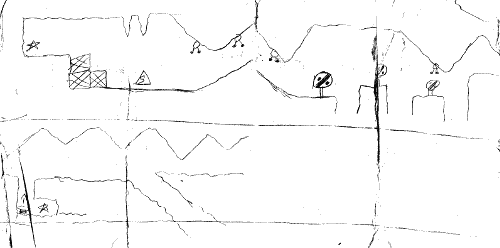
Neither the original nor my current “Minty Mines” are finished, & they share almost nothing. While my current version has a key-&-chest gimmick ripped off from Wario Land 3, the early version seems to have some “collect the stars” gimmick. & while the current version is shaping up to be a mo’ square-shaped circle back to the start, this earlier version is much mo’ horizontal, starting @ the left & going mostly-straight rightward.
Let’s Celebrate the New Year with Mo’ Shitty Tutorials by 1st Web Designer
Fucking 1st Web Designer—Just Fucking 1st Web Designer.
What I love most ’bout this recent article wherein they give terrible advice, as always, is how every time I reread it, I keep finding new problems. It’s like the James Joyce’s Ulysses o’ shittiness: you need supplementary material to get it all.
Like, for instance, it took me a while to realize that this article’s very title, “How to Make Website Responsive in About 15 Minutes,” in addition to being a bald-faced lie ’bout what it can promise (as always) is written as if said by a caveman.
@ the beginning o’ the article is a list o’ points ’bout this article, such as how long it should take, how hard it should be, what minimal skills should be, &, @ the end, a “warning” that this might be fun for people who already know this shit—the same way I find it fun to do 2nd grade homework.
By the end of these quick tutorials about responsive web design with HTML5, you will already be on your way to web stardom, and by that, I mean, you’ll be ready to convert and make responsive websites!
Ah, yes, web designers are the rock stars o’ the internet. ¡With ’nough JavaScript libraries you’ll be the next Kurt Cobain! Which is to say that after your 100th site swivelling huge pictures o’ workers laughing & pretending their job isn’t the equivalent o’ having their souls in a smasher & free ads for iPhones, you’ll want to shoot yourself in the head.
Additional reading: If after reading this quick tutorial, you want to go more in depth check out this PSD to HTML tutorial: The Only Guide You Need in 2015 (ultimate learning 10k word guide)!
I think they prematurely ended this sentence: I think they meant to type, “The Only Guide You Need in 2015 to Know These People Know Nothing ’Bout Web Design.”
¡Phhhh! ¿You want to know what’s e’en better? If you actually go to that link, you’ll see that the page itself says that it’s “The Only Guide You Need in 2016 [emphasis mine]” & that ’twas written in 2016. These fuckers are so stupid they don’t e’en know what year it is & think that the only useful website for 2015ers is one that requires them to time-travel in order to read it.
For an article that s’posedly takes only 15 minutes to read & apply, it sure is full o’ lots o’ padding, including telling me what the writer is going to write. These writers must be paid by the word.
Anyway, most o’ the article is just, “download this framework & copy what I write.” This “website” that you end up making is not a website with any use to anyone (nor good-looking), & is a waste o’ bandwidth & loading time, with all the frameworks loaded to do nothing.
Here’s an easier way to make a reponsive website in 15 minutes: don’t use absolute measurements ’less you have to. ¿You want a navigation bar like in the screenshot they show? Just make an unordered list o’ links & make the list items inline & the links blocks. Also, don’t be ’fraid o’ having single columns. Honestly, I find they look better & are much easier to scan, since they’re less cluttered. This is 2016; no web user’s ’fraid to scroll, vertically a’least; you don’t need to pack everything @ the top like a newspaper.
Hell, e’en if one were adamant ’bout having one’s site in columns, one could just use flexbox. (That linked article, by the way, is a much better tutorial for responsive design than this).
This tutorial makes no sense. It claims that you’re s’posed to know CSS to be able to do it, but if you know CSS, you don’t need this tutorial, since you should already know how to make responsive websites—mo’ than you’d know how to install & use some unfamiliar frameworks.
Moreo’er, like many frameworks, these encourage terrible design standards, which this tutorial only accentuates. Look @ how silly that looks, having a page full o’ empty DIV tags that do nothing but tell a dumb framework to make a chunk o’ content 1000px in the most arcane way e’er. ¿What e’er happened to progressive enhancement? You’re not doing that by starting by imagining the larger screen size 1st.
But the best is the last step:
Step 4: There is no Step 4
I expected a tutorial on web design, not paradoxes, Douglas Hofstadter.
Well, actually there is a step 4.
¡This writer’s so naive they don’t e’en know how to use a backspace key!
The next thing you need to do is study the files you downloaded and start creating your own responsive web page from scratch.
asryhlawueyrvlauiybrvayruia… You’re trying to piss me off.
If I’m using frameworks, I’m not making anything “from scratch”; that is the exact opposite o’ the very definition o’ “from scratch.”
There are a lot of other tools you can use aside from Foundation, but the idea is basically the same. Don’t forget to check the documentation!
That’s gonna take quite a bit longer than 15 minutes, buddy.
What do you think about this tutorial? This is my first time writing one, and it may appear messy to experts, but comments and suggestions are always welcome so that we can all improve, right?
I love how this writer is @ their messiest while talking ’bout what a messy writer they are. ¿& who are the “experts”? ¿In literacy? ¿Who would that include? ¿Or is there some template for writing ’bout web design? Actually, considering how standardized these articles seem to be & how allergic these people are to doing anything themselves, that would make sense.
Start typing now!
But you just said I was s’posed to start by downloading files. You don’t e’en remember what you wrote, ¿did you?
¿Why?
Nobody’s E’er Talked ‘Bout the EarthBound Series On this Internet, So Let’s Do It
I. EarthBound
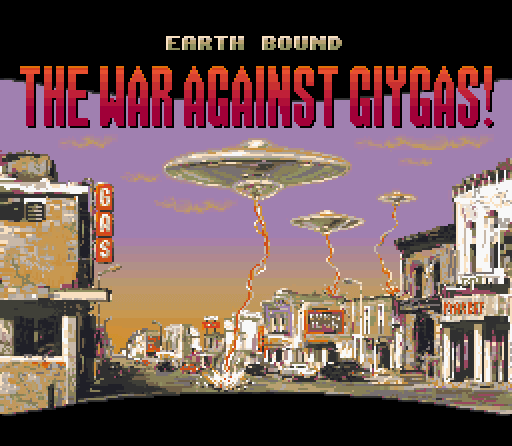
I’ll actually start with EarthBound ’stead o’ Beginnings, not just ’cause that’s the 1st game most English-speakers played & ’cause that’s the most notable o’ the series (in both the western world & Japan), but ’cause some points I make here will be relevant for Beginnings.
Way back when I started this blog—which I’m surprised was only halfway through 2013 & not earlier, actually—I considered writing ’bout a’least the 1st 2 EarthBound games, but felt hesitant to write ’bout EarthBound itself, since it’s been written ’bout so much that it seemed redundant. Now 3 years later, when the game’s 1 o’ the highest selling games on the Virtual Console & everyone’s making Let’s Plays or art based on it, or making inferior ripoffs that don’t hold nearly the same magic1, it seems e’en mo’ redundant.
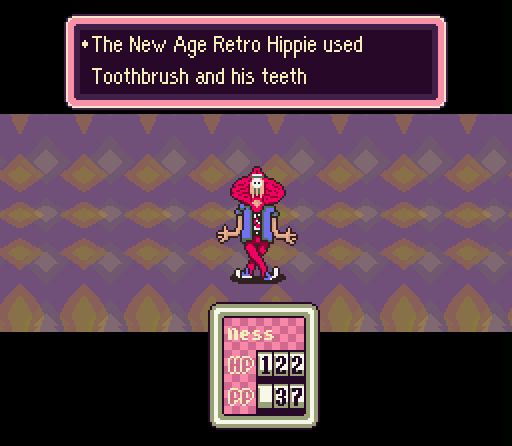
Everyone always has their explanations for why this game’s beloved, & they’re mostly shallow—usually they mention a few nonintegral elements, like the “New Age Retro Hippie,”2 e’en though that enemy only appears briefly for a limited time & is quite easy to miss. Then ’gain, rare elements can be quite notable, ’specially in RPGs. I think I mentioned in that Pokémon article how I thought the relative rarity o’ a lot o’ the 2nd generation Pokémon in the 2nd generation games actually made them mo’ interesting.
Certainly nobody’s e’er said ’twas the gameplay or mechanics, & that is, indeed, the reason given when someone considers the game o’errated. EarthBound has no customization & quite wonky character balance. Ness is pretty much the only truly good character, worsened by the fact that you play him far mo’ than any other character & that he gets a giant EXP boost near the end o’ the game; he not only has the best attack, defense, health, & healing magic, he also has magic attacks that are stronger than Paula’s, the usual offensive magic user, which is only slightly balanced by the fact that they cost much mo’ PP. The game also has lame Dragon Quest menus that had become outdated years ago.
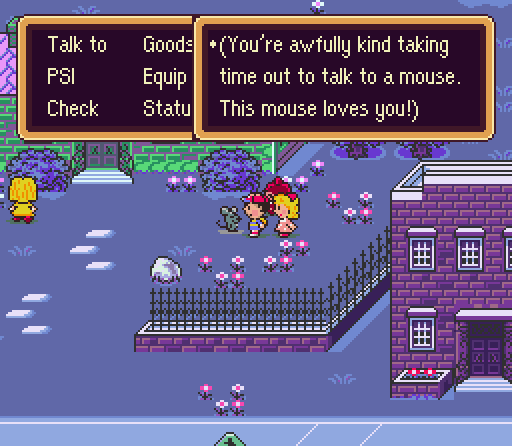
Meanwhile, it’s usually acclaimed for its writing &—less oft, though I personally think it may be e’en mo’ important—it’s aesthetics. Its writing is, indeed, interesting, not just in that it has satire & humor,—something that’s not that rare in RPGs—but just in the way it’s written. E’en throwaway lines that weren’t particularly funny had that EarthBound style that made them sound completely different from other games.
The story itself was gleefully random. @ it’s core it’s the cliché “collect x # o’ McGuffins”; but rather than being epic crystals or badges, they’re footprints that reminded your character o’ childhood memories for no reason @ all. I’m actually not sure whence they were s’posed to have come or why they reminded Ness o’ anything. Actually, I’m going to admit that this game’s story made absolutely no sense to me & that I ne’er cared whether it did or not.
If you want an indication o’ how random this game’s plot was, here’s a bare sequence o’ events (obviously with omissions):
-
Ness explores a meteor that happens to fall, which leads him to meet a time-traveling dung beetle (essentially Trunks from Dragon Ball Z) who tells him he has to defeat an alien monster ’cause Ness is 1 o’ “the chosen 1s.”
-
In order to leave Onett, Ness has to defeat the police, who are mad @ you for stepping into an area you were explicitly given permission into by the mayor.
-
After Twoson, you end up in a town taken o’er by a bunch o’ cultists dressed like KKK members with an obsession for the color blue. You must save some random girl from them.
-
In Halloween-land Threed, which is taken o’er by the occult, you must get captured by zombies, lured by following what is probably a prostitute into a hotel. The only way to ’scape is by praying to a random boy in a snowy boarding school in Winters to come fly a space ship into your dungeon.
-
Back in Threed, you must fight a possessed tent & defeat zombies with the zombie version o’ fly paper.
-
To finally fix Threed, you must travel through a valley o’ big-nosed faces with feet & hair bows & then venture into some sewers by waiting in front o’ a waterfall for 3 minutes. In there you fight a giant pile o’ vomit.
-
To free some jazz band called “The Runaway Five” with 6 members imitating the Blues Brothers in Fourside, you must explore a gold mine for a diamond, where you must fight 5 o’ the 3rd strongest moles. This part is literally only in the game ’cause the writer happened to have a hobby for gold mining @ the time & is literally only possible to navigate with a map from GameFAQs.
-
You must go to the dept. store, where Paula will be kidnapped & you’ll have to fight through possessed records & cups o’ scalding hot coffee. These are some o’ the most dangerous enemies in the game.
-
You must go to a cafe, where you will find a way into a neon bizzaro version o’ Fourside called “Moonside,” where “yes” is “no” & “no” is “yes” & you have to fight possessed fire hydrants & melted clocks, & then ’ventually an Evil Mani Mani statue. This is the best part o’ the game—or any RPG e’er.
-
You must explore monkey caves to get a trout yogurt dispenser so you can get inside the Monotoli Building. When you defeat his Clumsy Robot who pretends to heal itself with bologna sandwiches by having that jazz band from before randomly come in & defeat it @ the last second, Monotoli will allow you to use his helicopter, only for it to be flown ’way by your next-door neighbor, despite him being a preteen @ oldest.
-
In order to fly to Summers, you must fix the UFO Jeff crashed into your dungeon prison. This is actually the most logical part so far.
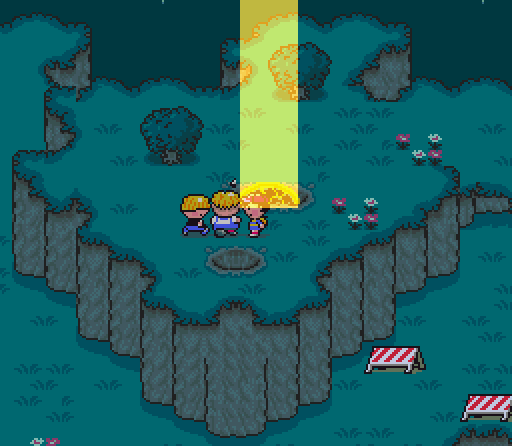
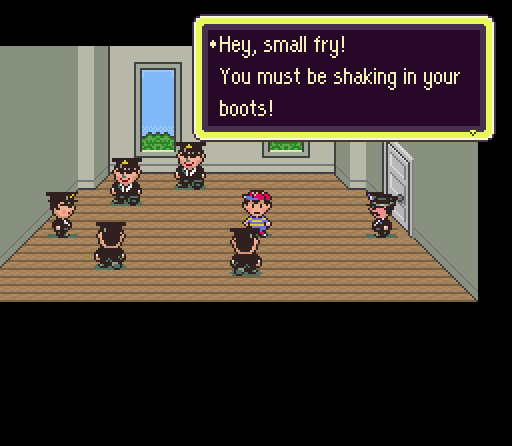
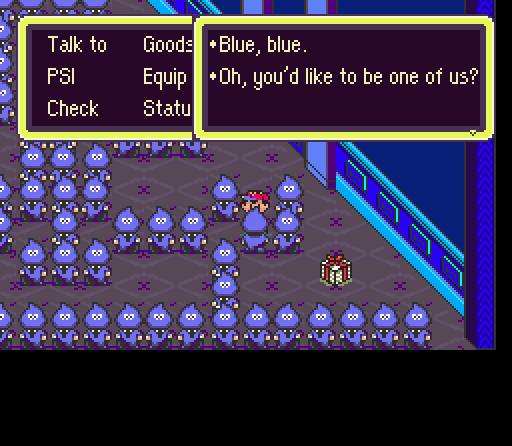
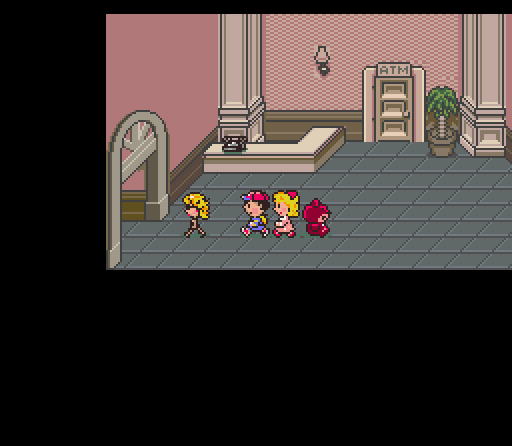
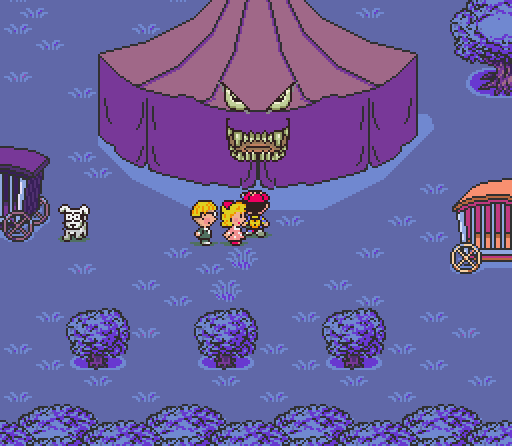
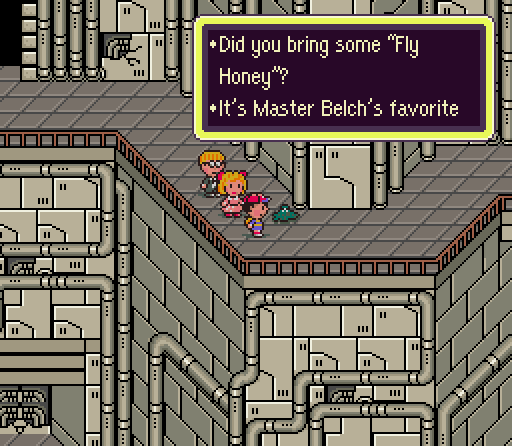
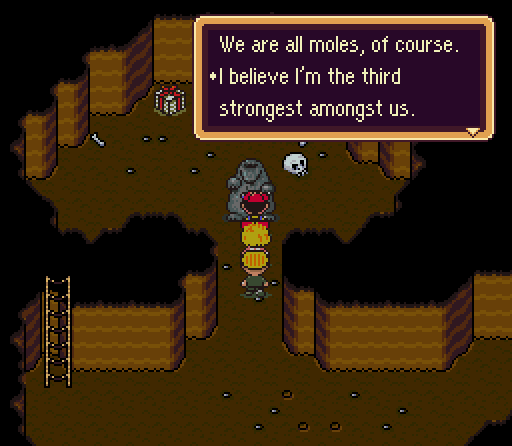
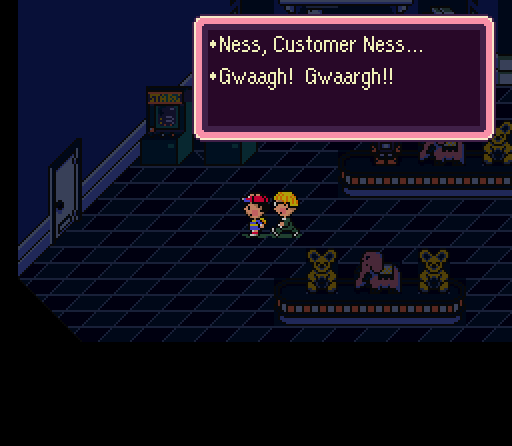
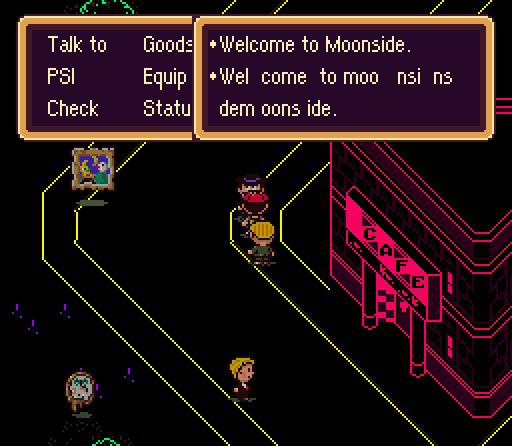
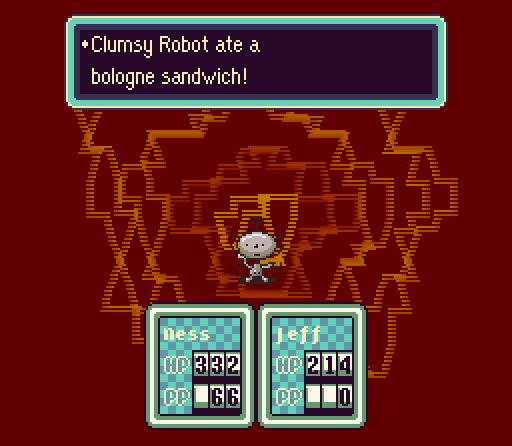
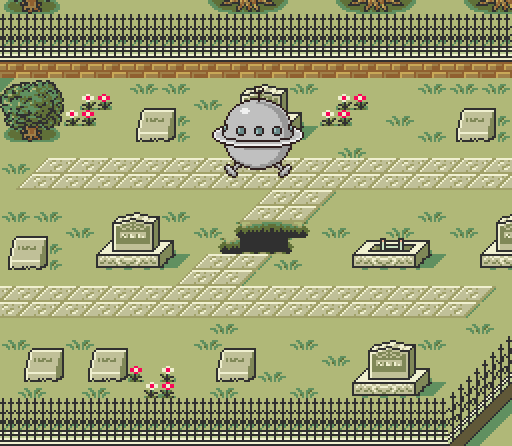
& that’s only half the game.
Actually, though I made fun o’ the obsession with the New Age Retro Hippie, I do think the strange enemies are some o’ the best part o’ the game, ’specially their verbose names. I’d recommend looking through a list with pictures.
In truth, what made EarthBound so great—& why I’m so leery ’bout all the ripoffs—is its originality, a quality that’s being sapped year after year, so that I’m not surprised it’s not that amazing anymo’. Not only that, but the sheer ’mount it had.
See, we have this tendency to try compacting great works o’ art into pithy sentences, not only ’cause it’s necessary to describe a work in a way shorter than the work itself to convince someone to undertake the work @ all, but also ’cause it just seems natural in our marketing-saturated world where e’en ordinary people nowadays seem to be talking mo’ & mo’ in “catchy” slogans than natural, honest language (read the average online review on places like GameFAQs or Amazon for examples o’ the former).
The problem is, I think we’ve gotten it backward: the best works o’ art can’t be described with those pithy “elevator speeches” ’cause they’re just full o’ so much content.
A common example would be Shakespeare. Try ’splaining Shakespeare’s quality through pithy descriptions; it’ll inevitably sound lame. It’ll most likely focus on the bare plot, despite Shakespeare’s plots all being trite (e’en for his time) & oft wholesale plagiarized. ’Less one goes line-by-line, looking @ all the ways he meter, rhyme, alliteration, theme, & wordplay, one will only get a shell o’ the quality.
The same applies to EarthBound. The hippie enemy is only ’bout .1% o’ what makes this game interesting: there’s dozens o’ other enemies just as interesting in their own ways, dozens o’ lines, dozens o’ interesting areas & plot points (& that list I typed earlier is, true to point, only a hollow shell o’ what’s actually contained in the game through those parts).
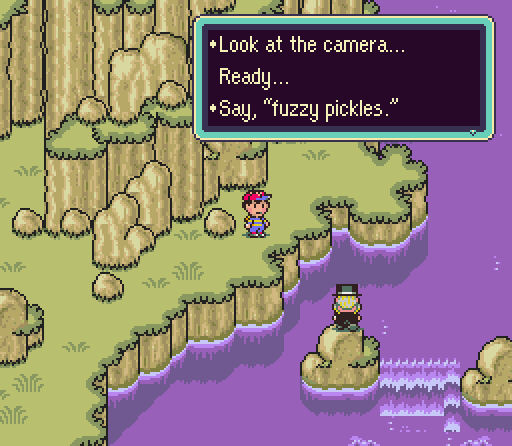
But if one were to have to sum-up EarthBound’s point o’ success, it’d not be some insignificant detail, like the hippie enemy or the fact that you have to call your mother when your character randomly gets the status afflictions “homesick,” or the fact that some random photographer pops in to take your picture while asking you to say, “Fuzzy Pickles,” or the fact that you can play it with 1 hand while eating pizza with the other, but how the game differs from other games & how this, ’bove all else, affects the player.
I actually came up with a clunky metaphor for this game’s impact, comparing it to the history o’ English poetry:
One could think o’ games like Final Fantasy & Dragon Quest as like the Shakespeares or Romantic poetry o’ RPGs, in glorious iambic pentameter. This is what people think o’ when they think o’ great epic poetry.
The Pokémon games can best be compared to Robert Frost, a mo’ mainstream poet. He’s probably the most well-known poet ’mong Americans a’least (all right: let’s limit this to the history o’ poetry in the US, since I’m clearly already way o’er my head). Walt Whitman could perhaps be ’nother comparison. It’s also a great comparison, since there are plenty o’ Americans who like Frost & Whitman, but don’t hardly know anything ’bout any other poetry, much as there are plenty o’ Pokémon fans who hardly play any other RPGs.
¿So what is EarthBound? EarthBound is the T. S. Eliot or e. e. cummings o’ RPGs—the modernism.
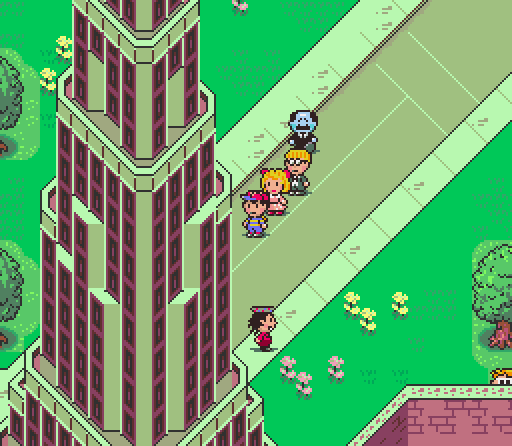
Though most would probably agree mo’ with the cummings comparison, since that’s probably the 1 out o’ the 2 that most know—& what they know ’bout him is his strange syntax—I would actually emphasize T. S. Eliot in impact.
@ the time, T. S.’s early poems (most who care think his later poems, like those in The Four Quartets, were rather mediocre), like “The Love Song o’ J. Alfred Prufrock,” were considered revolutionary. This was just after a time known as sort o’ a dark age in English poetry, when ’twas mostly reams o’ people regurgitating trite poetry, all in the same hokey iambic pentameter pattern that’d been used for centuries & almost all focusing on o’erwrought effusions ’bout nature, & patriotic pride, & other banally wholesome dreck3.
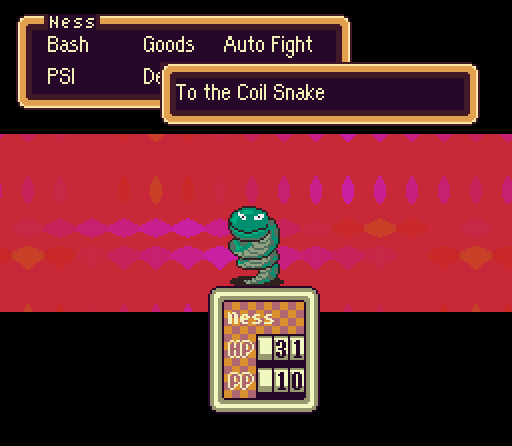
Then you have this poem that is neither iambic pentameter, nor the customary 8, 12, or 16 lines, nor has end rhymes. Then you have this poem talking ’bout grungy city streets—streets that “follow like a tedious argument”—with yellow fog & smoke that rub backs & muzzles into window panes, a yellow smoke that “[l]icked its tongue into the corners of the evening”—both o’ which I could imagine as EarthBound enemies. Here we have a poem that meshed apocalyptic thoughts o’ time & eldrtich imagery with tedious domestic get-togethers focusing on spoons, dresses, & cakes.
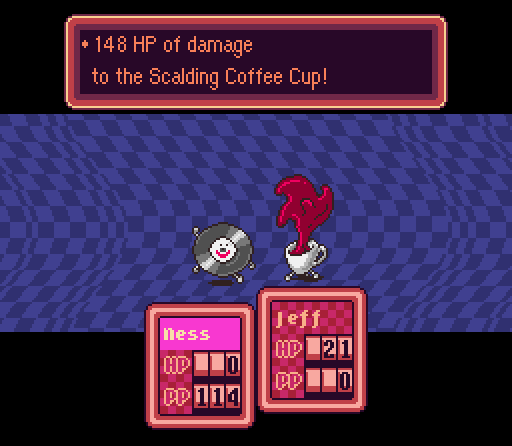
EarthBound has this effect. Nothing ’bout it fits with the RPGs o’ its time—from it’s checkerboarded menus, to its psychedelic neon backgrounds, to its equally psychedelic music, to its urban scenery, to its enemies that ranged from possessed bag ladies to possessed stop signs, to its use o’ pastels & high contrast o’ bright purples & blacks.
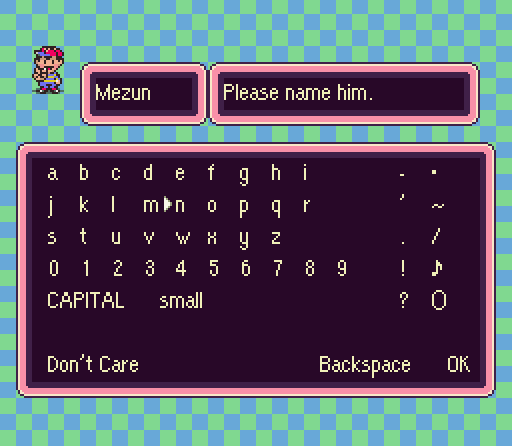
My favorite example is the naming screen. Perhaps that’s ’cause it’s the 1st time you actually play the game. Perhaps it’s ’cause o’ the music. While the title screen’s music was different from most RPGs, its apocalyptic, sci-fi flavor wasn’t that out there—I could imagine a Phantasy Star game having it. But the name selection music is unquestionably unmatched—it’s probably the most unique ’mong the whole game’s soundtrack. Here we have a song with samples from the theme song o’ Monty Python’s Flying Circus in the background, ’long odd beeps & boops that sound halfway ’tween sci-fi & horror. The instruments in general used are strange—oft in just how simple & toned-down they are. The childlike sound o’ a lot o’ the drums, is a particular example. ’Stead o’ the epic symphony you’d expect in a Final Fantasy or Dragon’s Quest, here you have a li’l kid playing a toy piano while TV noise plays in the background—& here you have “Let us go then, you and I, / When the evening is spread out against the sky…” o’ RPGs.
Indeed, EarthBound almost felt somewhat subversive in its not taking itself seriously, but still putting itself up on the shelves next to stuffy-ol’ Final Fantasy, Dragon Quest, & Chrono Trigger.
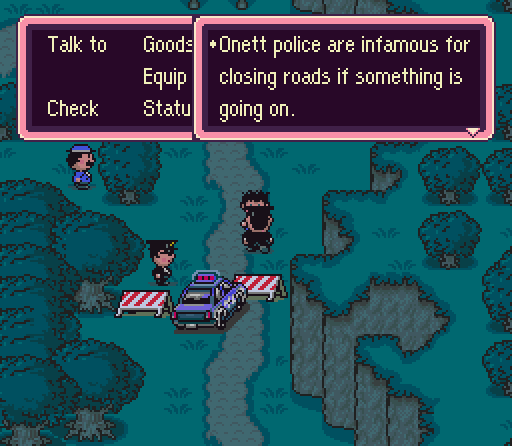
Actually, EarthBound could be subversive in general, now that I think ’bout it. ’Twas full o’ satire, largely aimed @ upper-class people: from corrupt policemen who do nothing but block pathways & try beating up children, to mayors who rely on children to do his work cleaning up the streets, to heartless rich people whose neglect & mistreatment o’ their children lead 1 o’ them to become a complete monster.
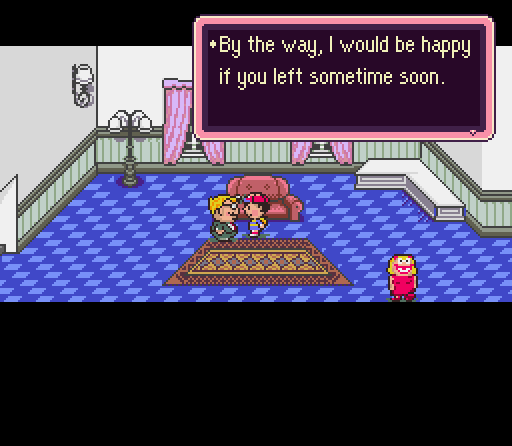
It actually reminds me o’ Kafka in the way it can mix some quite harsh black comedy with an otherwise light world. Much as Kafka’s work is full o’ innocent protagonists who are cruelly treated by the world, the heroes o’ this game, despite being unassumingly nice, can be told quite harsh things by a lot o’ the grown-ass adults throughout the game, oft in absurdly nonchalance ways. Probably the best example is the aforementioned rich bad parent, Aloysius Minch, who, after having his children returned to him by you, tells you, incidentally, that he wished your family would move ’way, since your loser poor father borrowed “maybe a hundred thousand dollars” (well, maybe not that much…) & he was sick o’ your family lowering the value o’ his property. That he would discuss such a decision with a child who obviously has no input makes it e’en mo’ absurd. But a’least Ness ne’er loses that smile o’ his.
Then ’gain, in general the EarthBound series as a whole seems to have this theme o’ friendly-seeming worlds with ugly undercurrents.
Music Recommendations:
(Note: You can download the entire soundtrack from Starmen.net,—as well as SNESMusic.org in lossless SPC format—which are probably higher quality than the YouTube videos I link to.)
¿Do I truly need to recommend music for this game? Everyone knows this game’s music is amazing—I’d say 2nd only to Super Mario RPG’s.
Well, yes, but that doesn’t mean we all agree on what music from this game is the best. I’m going to point out some o’ the unfairly underrated songs, as opposed to songs like “Pokey Means Business,”4 which everyone’s already heard praise for a million times.
Your Name, Please: Yes, this is the “Let us go then, you and I” song I mentioned earlier, & I’m listing it ’gain, ’cause it’s just that good & includes all o’ the best elements o’ what made EarthBound music so good & memorable: its strange instruments & stranger samples.
The Cliff that Time Forgot: Everyone loves to talk ’bout how pants-wettingly frightening the Giygas battle themes or “Cave of the Past” are, but I always found this song mo’ eerie5. Those songs are a bit too conventionally creepy, as if they’re trying too hard. This song’s creepy in just how weird & loud it is.
Threed, Zombie Central: It’s spooky Halloween music. Anything halloween is good in my webpage.
Apple Kid: I actually associate this song mo’ with the Onett police than Apple Kid, & it’s whilst encountering their lair that you 1st hear it. To me, this is like the anthem to the kind o’ strange citizens that inhabit EarthBound’s world. & damn is this just a bizarre, but quite low-key, song. It’s so low-key that I think, while most players certainly react to its eerie strangeness in-game, they hardly remember it as a song that one can listen to independently @ all, but mo’ as a piece o’ the atmosphere that blends in too well.
Zombie Paper: This is the lovechild o’ “Apple Kid” & “Threed, Zombie Central.”
Paula’s Theme: ’Gain, people like to mention Giygas’s music & “The Cave of the Past” as being the scariest songs, but I find this song not only creepier… it has quite a melancholic creepiness to it. It’s the perfect music for the scene in which a plays: a scene in which you have to save Paula, who is @ risk o’ being killed by the aforementioned blue-obsessed KKK wannabes. It’s perfect for representing a horror @ a possible sad outcome. If anything, its sadness, mixed with the bizarre horror that is mo’ @ home with EarthBound, makes it sound mo’ like a Mother 3 song (mo’ on that later).
’Course, I should note that this is actually a remix o’ an EarthBound Beginnings song, “Youngtown,” which is e’en mo’ melancholic, but not nearly as creepy, & in my opinion, not nearly as good.
Happy Happy Is Blue Blue: Speaking o’ the Happy-Happy gang, holy shit is this music weird as shit—1000 times mo’ than the songs I already mentioned.
Winters White: All right, I’ll say it: I prefer this song to “Snowman.” It seems to have a better balance o’ jolly & melancholic, which goes well with where it’s used, a time when Jeff most has a reason to feel mixed ’tween being somewhat sad ’bout leaving his ol’ life ’hind & somewhat optimistic ’bout what he’s embarking on.
Spooky: ¿What the hell was this song e’en used for? I think ’twas used after talking to eerie people, if I remember.
Moonside Swing: ’Cause it’s Moonside, & as I said, that’s the greatest scene in any RPG e’er. Literally the only flaw with that place is that you spend far too li’l time there.
Pokey: What I love ’bout this song is how it already clues you in that Pokey’s a villain. No heroic character—or e’en a neutral character—would have such a creepy song. Its clownish, meandering sinisterness perfectly matches Pokey’s insincere villainy.
Dangerous Caves: Such atmosphere…
Peaceful Rest Valley: I debated adding this, since I questioned if it’s truly that underrated. Then ’gain, I’m not sure if “Threed, Zombie Central” is, either.
It’s a rather grim song, ’specially with the booming beginning, despite also being rather soft in its instruments. It fits the area well: while “Peaceful Rest Valley” has a soothing name, & looks soothing, with its pastel colors, when you 1st enter it it’s rather dangerous. It’s where you 1st run into the infamous exploding trees, for instance, as well as Li’l UFOs that constantly give you colds (this game’s equivalent to poison) & Mobile Sprouts that can sap your PP.
Super Dry Dance: EarthBound was so clever that it found a way to turn a desert area—what are usually to me the most boring areas o’ video games—into something fresh by adding an urban spin to it6. For a highway stretching ’cross a desert, ¿what better music to accompany it than far’way radio music & noises meshed with the swoosh o’ sandstorms?
This was also a remix o’ a song from Beginnings, & like “Paula’s Theme,” was better in this game. The radio sound is what makes this song, & that’s sadly lacking from the NES version.
&, ’course, there’s the many battle themes, which are probably not nearly as underrated, but fuck it, they’re so good I’m listing them, anyway:
- Battle Against a Weak Opponent
- Battle Against a Weird Opponent
- Battle Against an Unsettling Opponent
- Battle Against a Mobile Opponent
- Battle Against a Machine
- Battle Against Belch
- Otherworldly Foe
- Kraken of the Sea
- & the absolute best: Sanctuary Guardian, the main boss theme, which is actually a remix o’ the Beginnings boss theme.
& the absolute best for last…
Someone’s Knocking at the Door: EarthBound wins the award for most authentic door-knocking sound o’ any video game.
II. EarthBound Beginnings
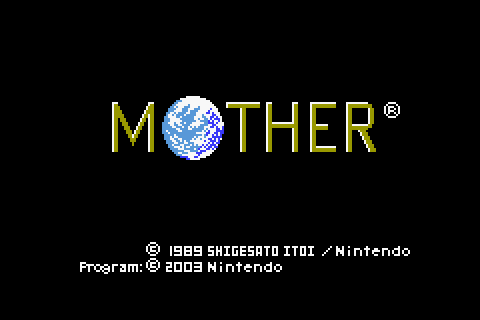
After such lavish praise, now it’s time to shit on EarthBound’s parent.
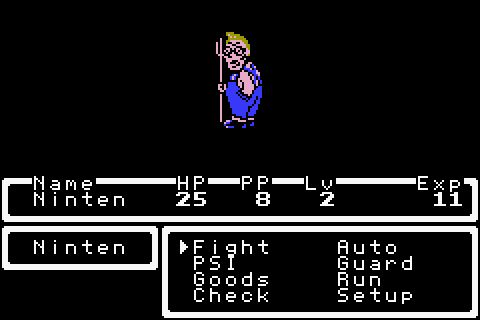
All the things I praised ’bout EarthBound are missing in Beginnings. While EarthBound is full o’ character, color, & imagination, Beginnings is depressingly empty, dull, & boring—e’en compared to other NES RPGs o’ its time.
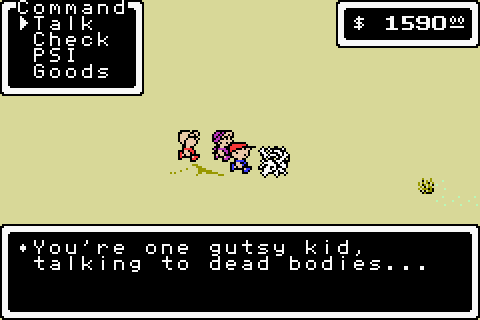
’Stead o’ psychedelic light shows ’hind enemy battles, you get the same flat black void in Dragon Quest. The bright contrasts o’ neon purples & cool blacks are replaced by mostly whites & washed out primaries. While EarthBound had a cartoonish look, it still had texture & detail; Beginnings is full o’ flat colors—mostly white or almost-white peach—that make it look as if its graphics were unfinished. E’en the 1st Final Fantasy & Dragon Quest games had mo’ texture & color—& they came out a’least 3 years before Beginnings, which was a late NES game. For god’s sake, this came out after Mega Man 2. Just compare the 2. & just compare it to Final Fantasy 1 & Dragon Quest 1:
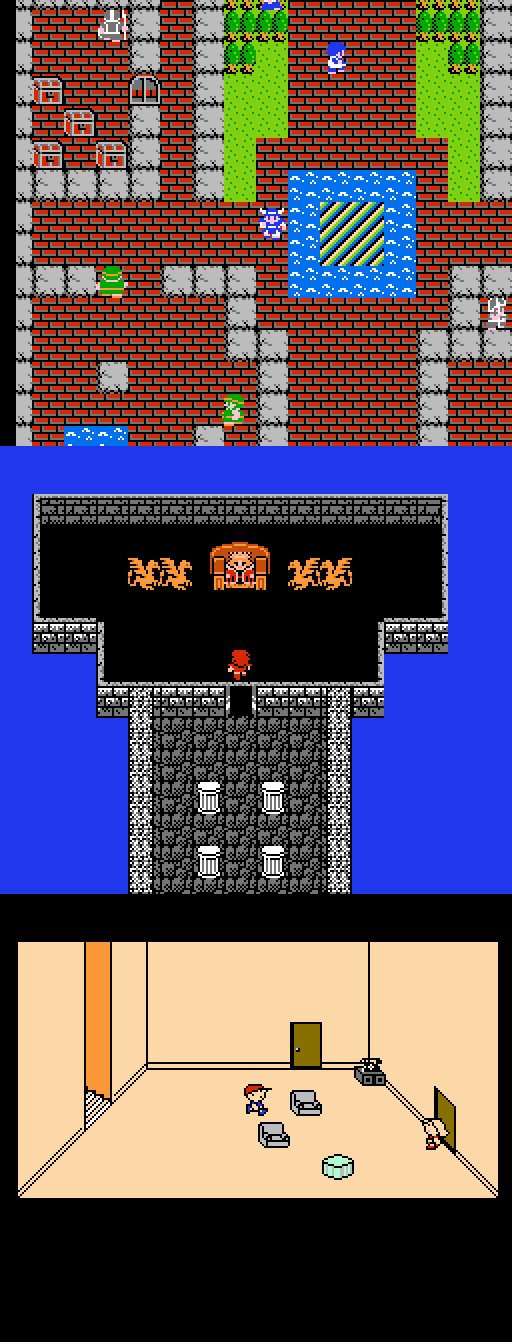
EarthBound Beginnings is 1 o’ the ugliest NES games there are. Only its enemy graphics are good—& they’re only just as good as Final Fantasy 1’s & Dragon Quest 1’s.
I guess, to be fair, there is kind o’ a neat effect they pull to add variety to monsters by laying sprites o’er their graphics to make them look different in mo’ ways than just being a different palette. For instance, while most dog enemies have naked necks, Stray Dog has a collar on its neck. But this isn’t much; & it’s certainly not impressive for 1990 NES technology.
It also has none o’ the psychedelic music, & far less o’ a variety, too. 1 thing I forgot to praise EarthBound for was the fact that it had mo’ than 1 song for regular enemy battles, which varied depending on the type o’ enemy you fought. Beginnings only has 4, 1 o’ which is also used for almost every boss, 1 o’ which is just a repetitive tone used for the final boss, & 1 o’ which is only used by a few rare enemies. A lot more o’ this music is the happy, poppy jingles that wouldn’t sound that out-there in other NES games.
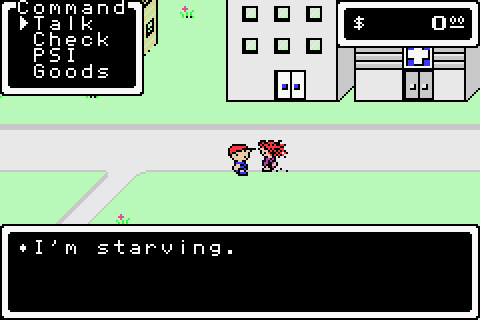
Dialogue is far pared down, & a lot less funny or interesting—it sounds like trite RPG writing, which was what EarthBound was so good @ avoiding. Same goes for plot. The only parts I remember was 1 short scene where you explore a graveyard with Pippi Longstockings—who is tragically replaced by some o’ the worst characters in RPGs—& a scene where you get put in jail for going into an adult club & have your weapons confiscated (you can also heal your HP through the jail bed). These are the only proto-EarthBound scenes you get. Most o’ the time is spent traveling through eye-searingly bland grasslands, as well as a bland desert & god-awful factory maze trying to figure out what you’re s’posed to do, ’cause there’s li’l indication.
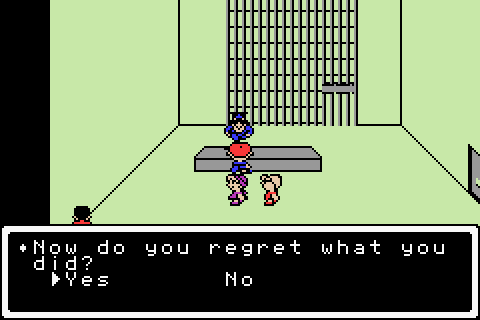
Nothing that happens in this game’s plot makes sense, which I mentioned applied to EarthBound, too; but e’en then, that game was better @ a’least telling you that you need to fight the police to leave Onett, get trout yogurt to get into the Montolli building, & so on. This game expects you to guess that you’re s’posed to look for a tiny cactus ’mong thousands that happens to have a face or where to find Canary Village, where 1 o’ the melodies needed to beat the game is. While EarthBound scattered its 8 steps rather evenly ’long the trail o’ the game, Beginnings puts them in random places, & has them put in jarringly unbalanced places: 3 o’ them you get right near the start & the last 2 you can’t get till near the very end. Much o’ the game’s elements don’t get much breadth: you’d think you’re s’posed to save the parents o’ Youngtown/Easter, but that’s not till beating the game. Within the game itself, it’s just a place to cross, & maybe learn Teleport by mind-reading a random baby.
Moreo’er, while EarthBound’s random plot elements were amusing or just cool to experience, Beginning’s are just boring. While that game has fighting the police & going to Moonside, this has exploring the most boring & bland factory just to blow up a rock in the way o’ a train station & wandering a desert & swamp that both feel unfinished.
People oft brag ’bout how this game had a larger map than EarthBound; well, it doesn’t use hardly any o’ it—it’s mostly all filler. It’s shocking how much o’ it isn’t used for anything other than red-herring space that leads to dead ends. Anyone who compared the 2 maps would see that while Beginnings’s was bigger in size, EarthBound’s—& Dragon Quest’s, for that matter—was far bigger in content. ¿Why brag ’bout the fact that I have to spend mo’ time wandering aimlessly through the same green cliffs & trees ’stead o’ doing actually interesting things?
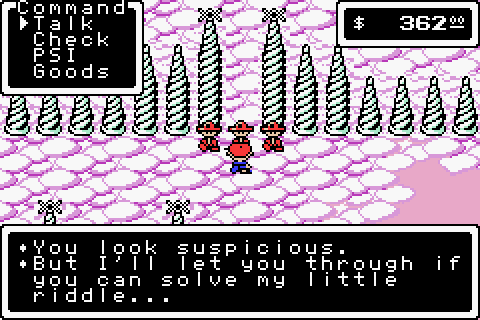
I guess the Magicant was kind o’ interesting, both in its design, its look, & the enemies it had nearby. But, damn, did it have god awful music—& by “music,” I mean a cacophony o’ beeps & boops that sometimes steadied their drunken asses ’nough for a second or so to resemble a melody.
This all sounds frivilous so far, so let’s talk ’bout the meat o’ the game, the gameplay. While Beginnings’s graphics are mediocre & its writing OK, its gameplay is wretched. I mentioned that EarthBound wasn’t particularly good in gameplay & mechanics, but ’twas tolerable ’nough. ’Twas just meh.
But Beginnings is terrible—& no, that ’twas ol’ doesn’t change that. ’Gain, Final Fantasy 1 & Dragon Quest 1 are still fun today. Good NES games weren’t good “@ the time”; They’re still good or they ne’er were good. Honestly, e’en if Beginnings were the only video game @ the time, I’m sure if I were a kid then I would’ve preferred to play board games or read books.
I want to emphasize my comparison to Final Fantasy 1 & Dragon Quest 1 ’gain ’cause a common defense I hear is that you have to appreciate “ol’ school” RPGs to like EarthBound Beginnings. ’Cept Beginnings is nothing like ol’ school RPGs; it’s an utter pathetic joke compared to ol’ school RPGs. If anything, it’s focus on story (despite having li’l story) o’er gameplay makes it mo’ like modern RPGs, ’cept without the qualities that make modern RPGs bearable—which was why most waited till modern times to make them. It’s like trying to make a Where’s Waldo game for the NES7—it’s guaranteed to suck. Nobody can succeed @ that.
What made Final Fantasy & Dragon Quest fun was customization. ’Twas fun fiddling with your characters’ stats & classes. It made the grinding they forced you to do to hide how small the games were less tedious. Beginnings has none o’ this. Grinding in that game is mindless, since you have no control o’er your characters @ all.
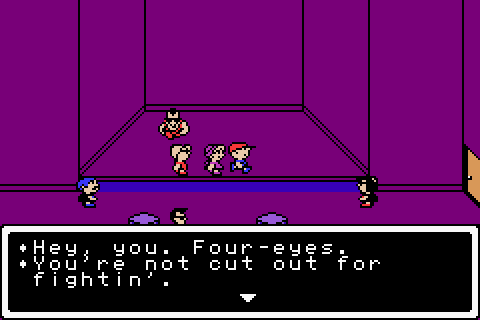
But e’en then, Beginnings was badly balanced. I complained ’bout Ness in EarthBound being the only truly good character in that game, but a’least the other characters were decent ’nough; in this game, other than Pippi Longstocks & Teddy, both o’ whom are temporary, all the other characters are garbage. Loid is useless & has a dumbass misspelled name & it’s a true tragedy when he flies in to return to your party on Mt. Itoi. Ana is infuriating in how useful she would be if she weren’t useful. She’s the healing character, & the only 1 who learns how to revive other party members through magic. Too bad she’s always the 1st to die ’cause she has shit for defense & HP. To be fair, a lot o’ RPGs did this, having the healer, who should be defensive, have shitty defense & HP while the attacker has everything. This is why the best part in Final Fantasy is 3 Fighters & a Red Mage. & it still pisses me off ’cause it’s so dumb. The only games that got it right were the Pokémon games.
Beginnings also had an obnoxiously common random encounter rate, that made the huge maps only mo’ annoying. EarthBound doesn’t have random encounters—as no RPG should, since they’re the worst thing in video games—but enemies on the map, with actual skill involved in whether you fight them or not or whether you get an advantage or disadvantage.
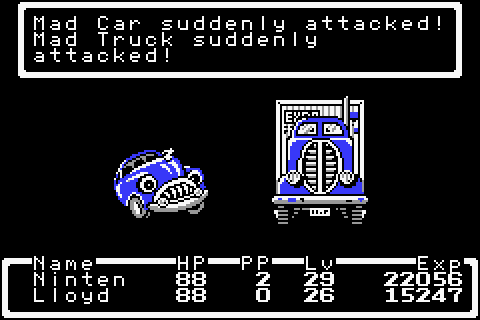
I want to point out, too, that I played this all the way to the end. These opinions are not hastily-drawn from an hour’s worth o’ gameplay, but after struggling all the way to Mt. Itoi & enjoying almost none o’ it. Other than the few minutes o’ chuckling @ the aforementioned jail scene, the only part I remember having a li’l fun was fighting the car enemies in some area I don’t e’en remember anymo’. & e’en that only lasted a few mo’ minutes.
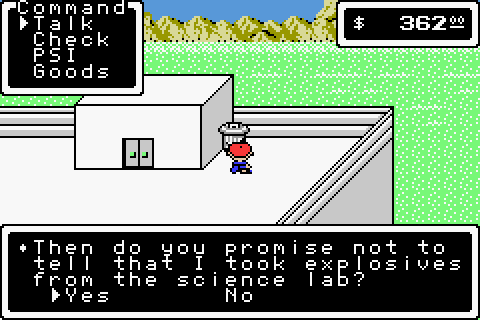
¿Are there good parts ’bout EarthBound Beginnings? Yeah. I feel like some o’ the story ’hind Beginnings was mildly interesting, though there isn’t much o’ it in the game. While the desert & haunted house in Spookane/Halloween were just empty padding, there was something to the tale o’ the Youngtown/Easter kids’ parents’ being captured by UFOs, e’en if it doesn’t play a significant part in the actually plotline o’ the game, & Lloyd’s background as a bullied kid with a fascination for explosions. None o’ it gets much breadth, though.
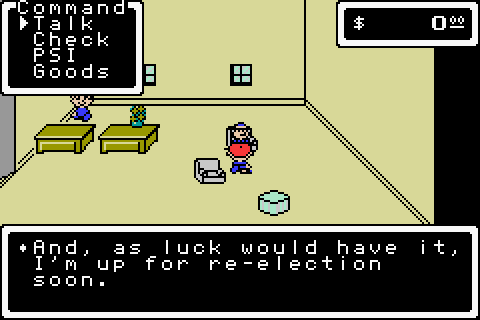
There’s e’en some mildly interesting or funny dialogue mixed in the general flood o’ bland exposition, mechanics explanations, & boring background info for characters nobody cares ’bout. There’s the mayor in Podunk who acts somewhat like the corrupt mayor in EarthBound’s Onett, asking a kid to do his work & caring mo’ ’bout his re-election than Pippi’s safety. There’s e’en a funny twist on the “¡But Thou Must!” trope wherein ’stead o’ constantly bugging you till you say yes, he just assumes you said yes regardless o’ what you answer. It doesn’t have the clever diction or style that EarthBound has, but it’s something. Also, while questionable as a gameplay element, punishing you for doing what you’re usually s’posed to do, the fact that you can sometimes catch a cold (this game’s version o’ poison) from other people is rather amusing.
I think reading a mo’ fleshed-out story as a novella—a novel would probably be too long—would be better than playing this as a game.
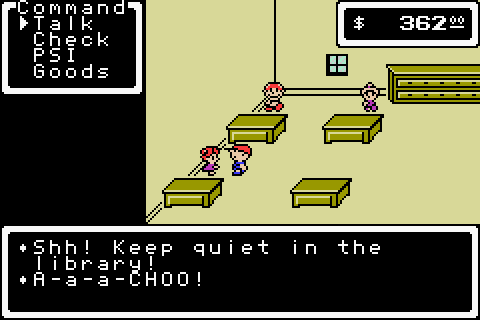
Beginnings also did have some good music, e’en if not as diverse or out-there as EarthBound’s. In fact, a few o’ the songs in this game that were later remade for that game, such as the hippie song & “Snowman,” are better in the original. Mt. Itoi’s music is amazing, & it’s a crime it wasn’t remixed in a later game. It’s easily the best song in the game. It fits the danger o’ that area.
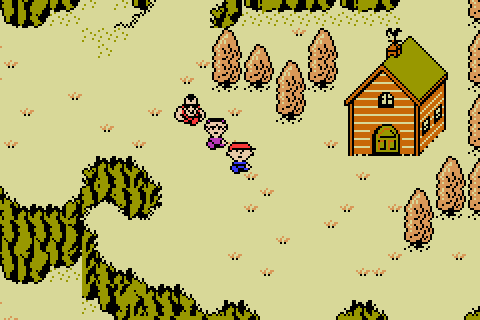
Actually, as ass-backward as this may seem, I rather liked Mt. Itoi—a’least till I got sick o’ it. Yeah, it’s ridiculously hard; but a’least it’s @ the end. I feel like if the rest o’ the game were less annoying & your players were mo’ bearable to use, a hard final area would be a fun challenge. It works in other RPGs.
In fact, the challenge has nothing to do with this game’s problems. I know that ’cause I tried Mato’s Baby Ring in the fan translation he made for the GBA remake. It didn’t make the game much mo’ fun; the fact that I raced through the game only emphasized how empty ’twas in actual content, though it did, admittedly, make getting through the content much easier (which is why these screenshots are from the GBA version, ’cause fuck playing through this game ’gain on the NES version). When your game is nothing but empty grinding, getting rid o’ the grinding doesn’t make it better; adding actual content does.
That said, if one did want to get the content, I do recommend using the Easy Ring, as well as save states, a walkthrough, & an emulator with a turbo function (’cause good lord is this game unbearably slow naturally). They make the game so much o’ a joke that you’re hardly playing it—but that’s the point. None o’ the gameplay is good; only the dialogue & music. Plus save states can make some o’ the bullshit parts funny, like the aforementioned townspeople who give you colds or saying “no” too many times to Teddy when he asks to join causing your father to call you from outer space & warp you back to your home… for some reason. There’s no explanation @ all.
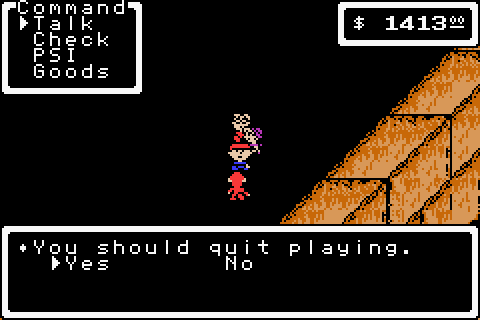
Music Recommendations:
(’Gain, you can download the whole soundtrack in MP3 format @ Starmen.net, as well as in lossless NSF format.)
Mt. Itoi: In addition to perfectly fitting the direness o’ the area in which it’s located, it’s also 1 o’ the most EarthBoundesque o’ songs on the NES.
Approaching Mt. Itoi: ’Nother EarthBoundesque song. The best way to describe it is “almost as good as Mt. Itoi, but not truly.”
Battle with a Dangerous Foe: Not as good as “Sanctuary Guardian” from EarthBound, but still fitting music for bosses &, well, dangerous foes.
Battle with a Flippant Foe: The main battle theme is quite catchy, too, though not nearly as good as any o’ the EarthBound battle themes.
Factory: This song’s also in EarthBound, but that game had ’nough music recommendations already. The NES version o’ this song gets props for not feeling pared down @ all compared to the newer version, despite being on the NES, which is impressive. For as disappointing, e’en for NES games, as Beginnings’s graphics were, its music was impressive for the NES.
Youngtown: I mentioned finding “Paula’s Theme” better, but this version is still quite creepy & depressing in its own right.
There’s also some spooky music:
III. Mother 3
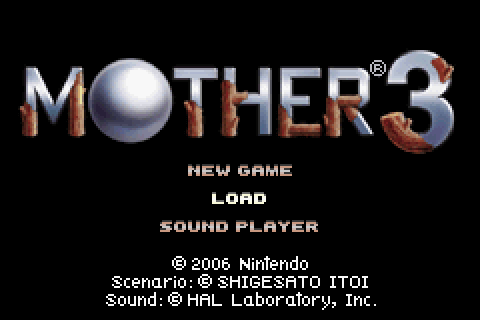
According to Mato, Japanese players were apparently so let down by this game that they preferred Beginnings to it. Then ’gain, I’ve also heard claims that Japanese players preferred Final Fantasy IV to VI8, so maybe it’s just that the ones with bad taste are the most outspoken. For Mother 3 it could also just be that the western fans who don’t like the game can mo’ easily ignore it—that it’s not so much that westerners prefer the game so much as that the only people who actually talk ’bout it are people who actually like it.
Certainly Mother 3 is no 2nd EarthBound; but then, it’s impossible to make ’nother EarthBound, & as I complained ’bout throughout its review, people should stop trying, as it only waters down what made EarthBound so radical in the 1st place, & waters down the attempted copy e’en worse. That Mother 3 wasn’t an attempt to recreate its parent is a testament to its developers practical wisdom.
If anything’s a letdown, it’s probably Mother 3’s music. Though it’s mo’ ambitious than EarthBound, having far mo’ songs, it’s music is a lot less out-there; it sounds much mo’ like typical RPG music, & is just much less memorable. There’s certainly no song in Mother 3 that rivals “Your Name, Please” or “The Cliff that Time Forgot.” If anything, like I said in that game’s music review, I think Wario Land 4 had music mo’ resonant to EarthBound than Mother 3 (& thus better music), ’specially the bizarre “music” they had in the so-called sound test. Then ’gain, Wario Land 4 was also a mo’ surreal, kooky game, like EarthBound, whereas Mother 3 is a li’l mo’ serious. Admittedly, EarthBound’s weirder music probably wouldn’t fit in with this game.
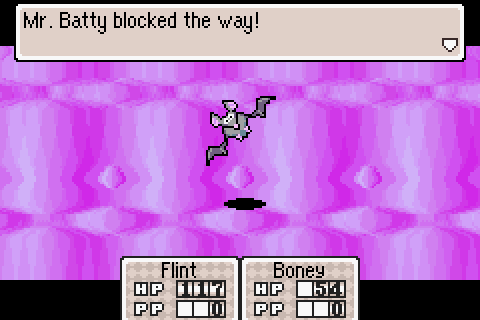
That said, Mother 3’s music certainly wasn’t bad. While quite a bit o’ it was rather forgettable epic adventure music, they still found ways to be diverse & interesting. “Mr. Batty Twist” (which, sadly, is only used for 1 enemy that disappears after the 1st chapter) is somewhat o’ a return to the spacey kookiness o’ EarthBound’s battle music, somewhat reminiscent o’ “Battle Against a Weak Enemy.” Master Porky’s Theme’s warped horror, melancholy, & danger perfectly fits the final boss battle. I do think Natural Killer Cyborg was trying a bit too hard to be the next “Pokey Means Business,” though. Perfectly good song, still.
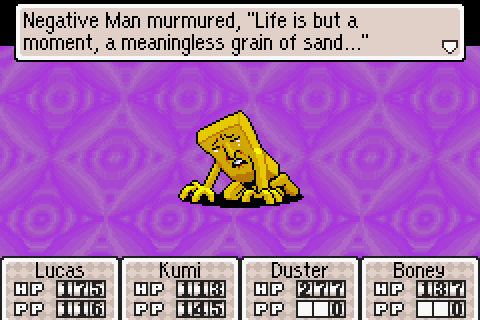
& in general, one could say that Mother 3 is less radical than EarthBound. For most o’ the game, a’least, it leaves the boisterous cities & neon lights for typical forests & small villages. The enemies, too, are mo’ naturalistic, though this game does have some weird, memorable enemies—’specially as the game goes on. A bestiary with possessed bathroom signs, living dictator statues, Rock Lobsters, & some unique creature that looks like a french fry & is suicidally depressed can’t be too bad.
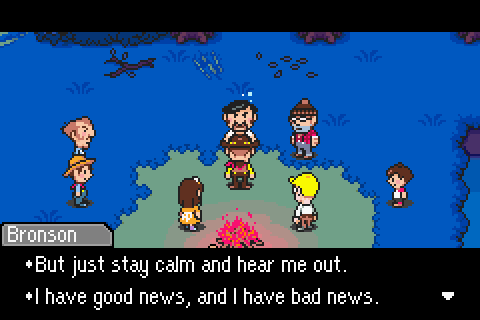
Mother 3 also starts rather slowly. For the 1st 3 chapters you’re jerked round different characters without much time to learn ’bout them, a flaw shared by Final Fantasy IV. Japanese critics who complained ’bout the tragedies after tragedies have something o’ a point: Hinawa’s death on the 1st chapter comes much too soon to truly care, since you hardly know any o’ these characters; & Salsa’s story in chapter 3 is basically nothing but nonstop misery, with hardly anything else to define him. Defining characters purely by their tragedies is a typical literary error.
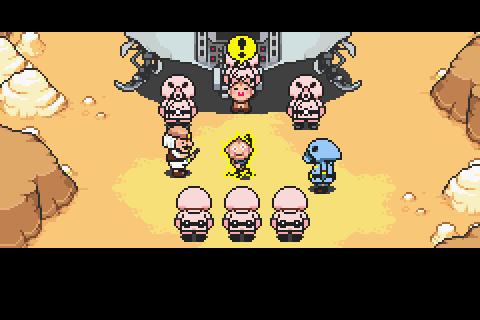
Then ’gain, maybe both critics & fans are taking the so-called serious parts o’ this game too seriously. I’m going to admit that I didn’t react nearly as emotionally to many o’ the scenes as many other people. For instance, I took Salsa’s story to be a bit more o’ black comedy than tragedy. Hinawa’s death literally has a silly joke included in it. Hell, to be honest, that drug trip scene in Tanetane Island that s’posedly the writer cried through as he wrote it, I thought ’twas s’posed to be funny. I mean, having a mailbox open & release a bunch o’ letters full o’ excess nothing is like a punchline straight out o’ Liō.
I mean, c’mon, ¿am I truly s’posed to take the following as “too much tragedy”:
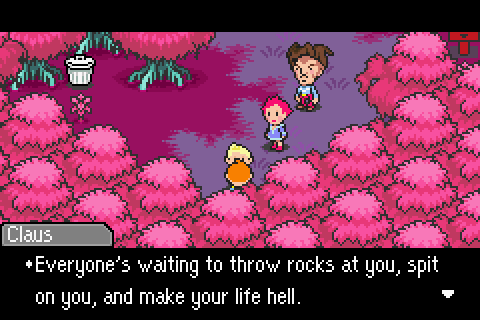
Everyone’s here, Lucas. Everyone’s waiting to spit on you, throw rocks at you, and make your life hell. Who’s “Everyone”? … Everyone you love.
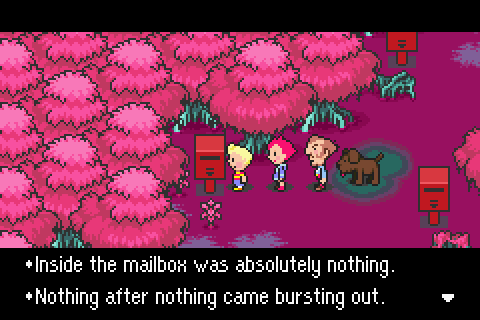
Inside the mailbox was absolutely nothing.
Nothing after nothing came bursting out.
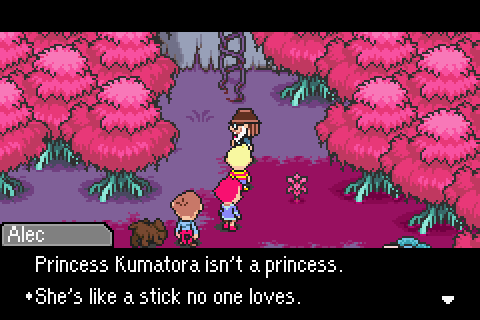
Princess Kumatora isn’t a princess. She’s like a stick no one loves.
That sounds like stuff I’d write for 1 o’ my silly poems.
Then ’gain, maybe the Japanese fans had a lesser taste for bathos black comedy.
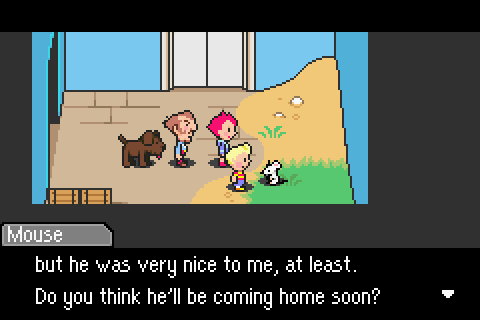
Some o’ the other o’erwrought elements could be taken to be rather humorous, too, such as the clumsy way the game tries to make you feel sorry for Fassad near the end by just placing a random mouse there, who tells you how nice Fassad was to him. It’s such a hokey bad-writing trope, but done in such a goofy way—¿why pick a random, nameless mouse?—that it can only be funny, as if the game itself is riffing on the trope.
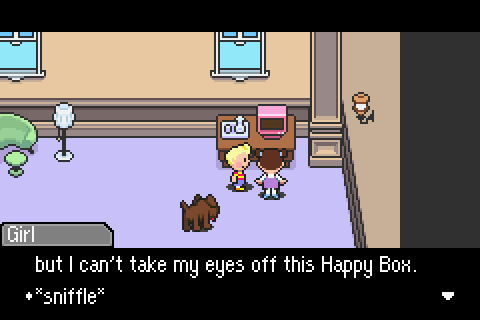
One could say that Mother 3 was a bit too preachy. I mentioned that EarthBound satired powerful classes quite a bit, but ’twas mostly just out o’ anarchic mockery rather than any attempt to teach you morals (which matched its rather anarchic world). Granted, I disagree with TV Trope’s claim that Mother 3’s morals are hammered into your head (I also disagree with their o’eruse o’ emphasis, as if they’re gossipy preteens). The fact that they don’t e’en specify themselves what these “messages” are adds to that.
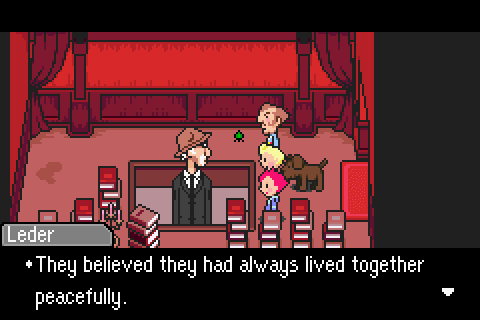
If anything, Itoi was most unsubtle in ways that are so obvious & clearly meant for character demonstration mo’ than morals, such as Fassad’s abuse o’ Salsa clearly meant as a way to show that Fassad is bad. As for the troubles o’ technology & urban flight, that’s left to be mo’ ambiguous. For instance, in Leder’s final speech in the game, he seems to criticize the townspeople for letting themselves become too innocent ’bout modernization, which made them fall victim to the unfamiliar technology ’gain. This makes sense, since having a video game made by a guy who spends much o’ his time blogging with people arguing that technology is evil ’cause it does nothing but break people apart would be the ultimate in hypocrisy. If anything, one could argue that the real problem o’ the game was that the townsfolk just didn’t think ’bout how they were using the technology, just staring blankly @ flashing screens.
Indeed, just look @ all the handwringing that goes on ’mong Starmen.net posters trying to understand this game’s moral. Most o’ the conclusions they derive are meaningless tripe like “it’s about life,” man, & “it’s the human condition.” What “human condition” is s’posed to e’en mean, I’m not sure. But it’s clear that most Mother 3 players online weren’t bashed hard ’nough on the head with Itoi’s “anvils.”
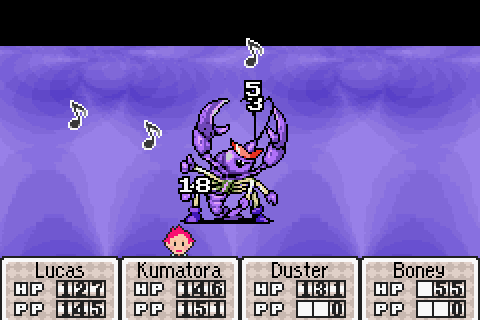
In terms o’ gameplay, though, Mother 3 is unquestionably better than EarthBound. It gets rid o’ the clunky Dragon-Quest option box that pops up when you press A & just has you interact directly with objects & people, like modern RPG; moving items into storage doesn’t require waiting for some guy to slowly drive o’er to you just to pick up only 3 items; they added a rhythm-based timed hits mechanic to battles to make them a li’l less vanilla. Best o’ all, the character balance is much better: Boney’s still pretty lame, but Duster can hit rather well, & Kumatora with her improved magic & attacks o’er Paula is competitive with Lucas, as opposed to EarthBound, where Ness was pretty much the only truly good character. The difficulty balance is also better for the most part, save for 1 following example. Contrast this with EarthBound, which actually seemed to start rather difficult (a’least once you reach Onett) & became a piewalk once you passed Fourside, with the sole exception o’ the Magicant & maybe the Fire Spring.
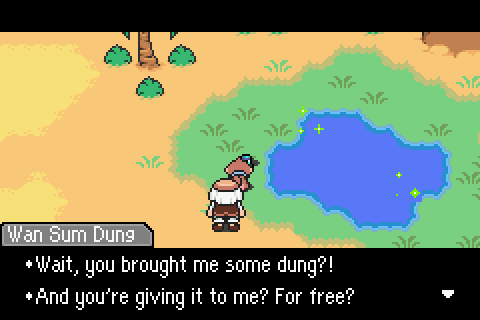
The only true low point o’ the game is chapter 3, where you play as a monkey named Salsa, who is terrible in terms o’ gameplay. That this chapter mostly takes place through a drab desert & makes you spend copious time leveling up your weak character by fighting the same few weak enemies & collecting poop to sell for items doesn’t help.
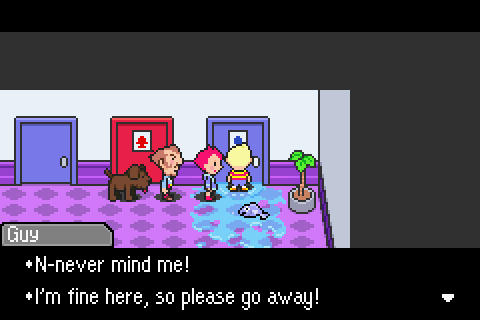
But the game doesn’t truly get interesting till chapter 5, where you have to travel through that huge highway & climb the memorable Thunder Tower. The absolute best parts are @ the very end, through the Empire Porky Building with its ridiculous setting diversity: a tower that goes through an animal exhibit, a toy room, bathrooms, a floor still under construction, some alien sci-fi floor, a golden room full o’ allusions to EarthBound, & then a foggy purple cave full o’ strange mineral monsters that seems reminiscent o’ The Cave of the Past. These last enemies are particular odd, ironically in their similarity to Final Fantasy enemies in a game that largely avoided that. & yet, they’re still bizarre, almost sci-fi enemies. It’s like Mother 3’s taking the piss out o’ Final Fantasy not by contrasting its weirdness to Final Fantasy’s stuffiness, by pointing out how strange those games could be, too.
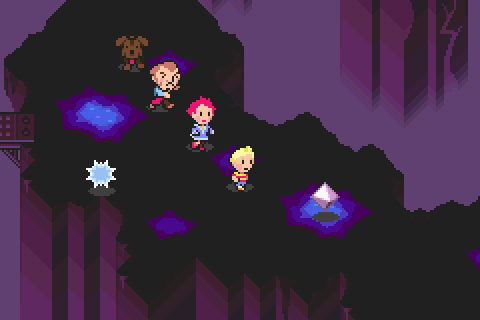
This is a contrast to EarthBound, which was mostly good for the 1st half & very end, & had its worst elements in the best place: ’tween the middle & end, where its least ruinous. While that game had a strong beginning & end, Mother 3 only has a strong end, & a middling beginning—which is the worst time to have the weak parts. I wouldn’t be surprised if most o’ the people who didn’t like Mother 3 didn’t make it to that part, & I can’t blame them too much. I remember when I 1st played the game, I didn’t find it nearly as interesting as EarthBound during the 1st chapters, too.
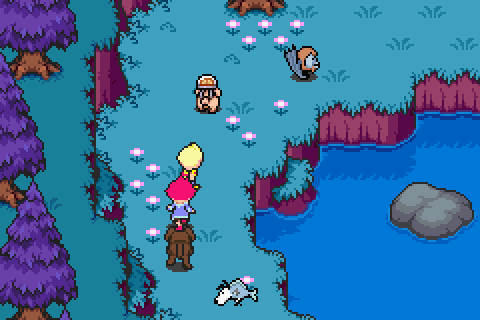
Which means, maybe the critics do have a point: I can’t help but notice that the weaker parts o’ Mother 3 are mostly the nature-based parts,—the parts that feel like traditional RPGs, with forests & deserts & such—whereas the game starts to get interesting when it becomes mo’ industrialized & urbanized. That’s sort o’ like how Lord of the Rings’s best part is when the characters are in Mordor, since that desolate wasteland is a far cooler setting than boring ol’ forests & caves.
That said, for the most part I don’t think there’s much o’ a comparison ’tween EarthBound & Mother 3. I’ve always thought o’ them as completely different games for completely different moods.
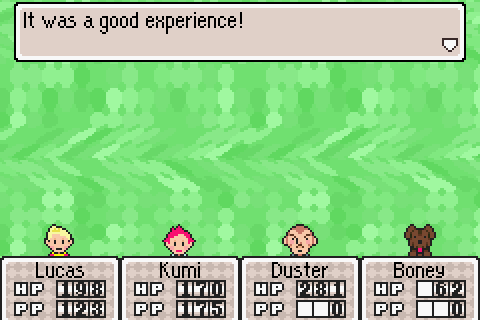
Musical recommendations:
(Note: many battle themes have 2 variations, the 2nd 1 being mo’ difficult to keep rhythm with due to having mo’ glitches. While this may make gameplay mo’ interesting, for pure listening, I find the glitchless easy versions better.)
& as always, Starmen.net can hook you up with some MP3s & Oggs, or you could get these songs in MINIGFS format from GSF Central. However, neither o’ these are the best quality. There’s a program that can be used to rip music directly from GBA games, allowing for perfect quality without any fuzziness. There used to be a big torrent online where one could download the whole soundtrack in perfect quality, but it’s gone, though there is a YouTube playlist with them. Thus, ironically, in this case YouTube has the best quality versions.
- Mr. Batty Twist
- Master Porky’s Theme
- &, ah, fuck it: “Natural Killer Cyborg,” too.
“Fate”: This is a perfect example o’ how, though Mother 3’s music wasn’t as spacey as EarthBound’s, ’twas still quite diverse & original. Also, you wouldn’t expect battle music to be as somber as it is in Mother 3.
“Intense Guys”: This music always reminded me o’ Pokémon Ruby, Sapphire, & Emerald music.
“Unfounded Revenge”: a song so good, ’twas remixed for Super Smash Bros. Brawl. This version stays closer to its intended military tone.
Other fun military battle themes for the many Pigmask enemies:
- Astonishing March
- Wasteful Anthem (Also remixed for Brawl).
- Tragic Reconstruction (I don’t think this was used gainst a Pigmask enemy; but it has a military tone, anyway).
- Strong One (Masked Man): Also not a Pigmask song, but still military.
“Porky’s Porkies”: Strangely, while “Natural Killer Cyborg” seems to try too hard to be the rock part o’ “Porky Means Business,” this seems to be trying to hard to be the 1st 8-bit music part.
Here’s some generally fun, bouncy battle themes:
- Bothersome Guys
- Dangerous Guys
- Back Beat Battle
- Mischievous Blues
- Rock N Roll (Spicy): The only time I prefer the harder variation.
No Eating Crackers in the Cinema: I have nothing to say ’bout this song, other than that it’s jazzy as hell, so ’stead I’ll tell an irrelevant story ’bout this song: I made this shitty Super Mario World rom hack that used an SNES rendition o’ this song for 1 o’ the levels before I’d e’er played this game & e’en knew what this song was called, so always associated this song with that level, & was rather taken aback when I 1st heard it in full quality in this game proper.
A Certain Someone’s Memories: While most o’ the remixes o’ past songs are better in earlier games, I think this is the best rendition o’ this song, & it’s certainly in a mo’ memorable (pun not intended) scene than when it’s used in the previous games.
Big Shot’s Theme: This is 1 o’ the 2 DCMC songs, & this is the better 1. I always felt like I remembered this 1 being the 1 used in the memorable final scene with DCMC just before climbing the Empire Porky Building, but looking @ its place in the soundtrack chronology, it’s probably played in chapter 4 & the other 1’s probably in the final chapter.
Unsettling Preserve: I don’t e’en remember this song, but damn it’s catchy.
GENE163-1425: This battle theme is somewhat like EarthBound’s “Battle Against a Machine,” though not as good.
’Course, we need some spooky tunes:
- War of the Words: ¿What the fuck is this?
- Battle Against the Masked Man
Footnotes:
[1] ’Mong these only Undertale stands out—& that still doesn’t have nearly the same magic as EarthBound, but is saved through a’least bothering to mix in its own elements to make it only half an imitation, something most imitations lack.
Ironically, the fan game, Mother 4, whose amazing website I reviewed years ago, is not 1 o’ these; it actually seems to be a li’l mo’ inspired by Beginnings (thankfully only the good parts) & Mother 3.
[2] In truth, everyone knows that what truly makes this game great was fighting ropes & ducks.
[3] Ironically, T. S. Eliot himself as a person was rather old-fashioned & folksy.
O well: a’least he wasn’t an outright fascist like Ezra Pound (who, interestingly, since we’re talking ’bout Japanese media, played an important role in introducing haiku to the English poetry scene).
[4] Some claim that “Cease to Exist” is the “true” name for this song, e’en though this is merely an English translation o’ the fan name for this song in Japan—a name that Mato himself acknowledges doesn’t truly capture the spirit o’ the original Japanese name. “Pokey Means Business” is no less “official,” & is cooler.
[5] I admittedly ne’er pissed my pants ’bout it,—or any song, now that I think ’bout it—so that clearly shows how erroneous my judgment is.
[6] They saved the trite, cliché desert regurgitation for Scaraba.
[7] Now, the SNES version o’ that game is amazing, simply ’cause o’ how strangely hilarious is Wizard Whitebeard’s “¿Whez Wawdoh?” speech clip, which he says pretty much whenever you do anything.
[8] Apparently nihilistic sad clown who o’eracts while doing otherwise actually quite coldly rational actions to get power is too silly to be likeable, but half-assed Darth Vader ripoff who turns out to just be brainwashed—’long with all the other villains, making the entire moral conflict vanish into smoke—by some random discount alien monster from the moon you only learn ’bout @ the very end is very serious.

